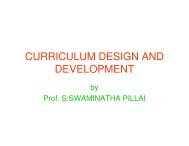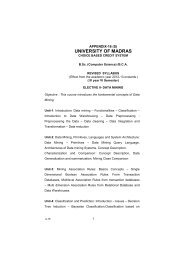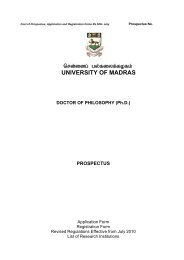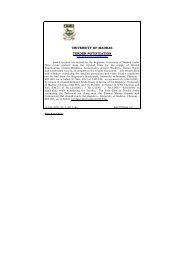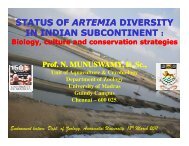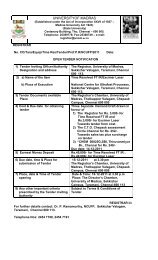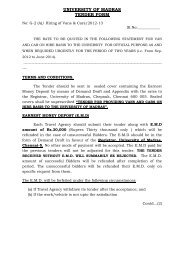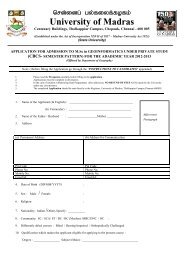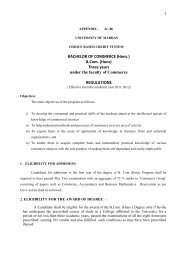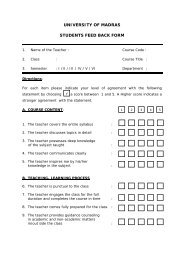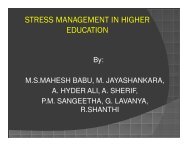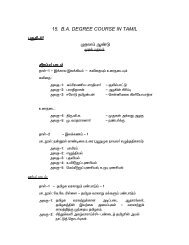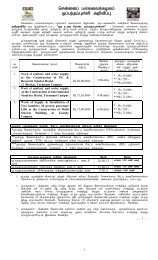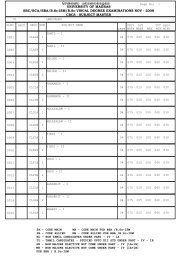The revised Scheme of examinations and syllabus relating to M.Sc ...
The revised Scheme of examinations and syllabus relating to M.Sc ...
The revised Scheme of examinations and syllabus relating to M.Sc ...
You also want an ePaper? Increase the reach of your titles
YUMPU automatically turns print PDFs into web optimized ePapers that Google loves.
APPENDIX-7(R)UNIVERSITY OF MADRASM.<strong>Sc</strong>. DEGREE COURSE IN BOTANY(UNDER CHOICED BASED CREDIT SYSTEM)(<strong>to</strong> take effect from the academic year 2012-2013 <strong>and</strong> thereafter)I. That in the Regulations <strong>relating</strong> <strong>to</strong> M.<strong>Sc</strong>. Degree Course in Botany– under Regulation No. 5-<strong><strong>Sc</strong>heme</strong> <strong>of</strong> Examinations be modified <strong>to</strong>read as follows.REVISED SCHEME OF EXAMINATIONS:I YEARCourseComponentTitle <strong>of</strong> thepaperFIRST SEMESTERInst.Hrs.CreditExamHrsCIAMarksExtTotalCOREPAPER-ICOREPAPER-IICOREPAPER-IIIElective - IElectrive -IIS<strong>of</strong>t Skill - IPlant Diversity-I- Phycology,Mycology,BryologyPlant Diversity-IIPteridophytes,Gymnosperms<strong>and</strong>PaleobotanyPractical-ICovering<strong>The</strong>ory Papers I<strong>and</strong> IIMicrobiology(or)EvolutionPlant ResearchMethodology(or)Ethno botanyS<strong>of</strong>t Skilledcourse 16 4 3 25 75 1006 4 3 25 75 1008 4 4 40 60 1004 3 3 25 75 1004 3 3 25 75 1002 1X2=2 3 25 75 1001
SECOND SEMESTERSEMESTERTitle <strong>of</strong> thepaperIns.Hrs.CreditExamHrsCIAMarksExtTotalCOREPAPER-IVCOREPAPER-VCOREPAPER-VICOREPAPER-VIIElective – IIIExtraDisciplinary–IS<strong>of</strong>t Skill - IIPlant DiversityIII – Taxonomy<strong>and</strong> EconomicBotany <strong>of</strong>AngiospermsDevelopmentalBotany-Ana<strong>to</strong>my,Embryology<strong>and</strong>Palynology <strong>of</strong>AngiospermsEnvironmentalBotany,Phy<strong>to</strong>geography<strong>and</strong> RemotesensingPractical IICovering<strong>The</strong>ory PapersIV, V <strong>and</strong> VIBioinformatics(or)BionanotechnologyHerbal DrugBiotechnologyS<strong>of</strong>t Skilledcourse - 25 4 3 25 75 1005 4 3 25 75 1005 4 3 25 75 1005 4 3 40 60 1004 3 3 25 75 1004 3 3 25 75 1002 2 3 25 75 100II YEARTHIRD SEMESTERCourseComponentCOREPAPER-VIIICOREPAPER-IXSubjectTitle <strong>of</strong> thepaperCell Biology<strong>and</strong> GeneticsPlantMolecularBiologyInst.HrsCreditExamHrsMarksCIA Ext Total5 4 3 25 75 1005 4 3 25 75 1002
COREPAPER-XCOREPAPER-XIElective IVApplied Plantcell <strong>and</strong> TissueCulturePractical III -Coveringtheory papersVIII, IX & XBiostatistics(or) WoodTechnology5 4 3 25 75 1005 4 4 40 60 1004 3 4 25 75 100Extradisciplinary- IIPlantBiotechnology4 3 3 25 75 100Internship* 2 - - - 100S<strong>of</strong>t Skill- IIIS<strong>of</strong>t SkillCourse - 32 2 3 25 75 100* Internship will be carried out during the summer vacation <strong>of</strong> theFirst Year (IInd Semester) <strong>and</strong> marks should be sent <strong>to</strong> theuniversity by the college <strong>and</strong> the same will be included in thethird Semester statement <strong>of</strong> marks.FOURTH SEMESTERCourseComponentSubjectTitle <strong>of</strong> thepaperInst.HrsCreditExamHrsMarksCIA Ext TotalCOREPAPER-XIICOREPAPER-XIIICOREPAPER-XIVPlantBiochemistry<strong>and</strong>BiophysicsPlantPhysiologyPracticals - IV-Coveringtheory papersXI <strong>and</strong> XII6 4 3 25 75 1006 4 3 25 75 1006 4 4 40 60 100COREPAPER-XVProject /Review <strong>of</strong>Literature6 4 40Viva - 20Presentation-2060 1003
Elective- VS<strong>of</strong>t Skill IVAlgalBiotechnology(or) AppliedPlant PathologyS<strong>of</strong>t SkillCourse - 44 3 3 25 75 1002 2 3 25 75 100II. <strong>The</strong> above amendment <strong>to</strong> the Regulations take effect from theacademic year 2012-2013 <strong>and</strong> thereafter.AC.S’12*****4
APPENDIX-7(R)UNIVERSITY OF MADRASM.<strong>Sc</strong>. DEGREE COURSE IN BOTANY(UNDER CHOICED BASED CREDIT SYSTEM)(<strong>to</strong> take effect from the academic year 2012-2013 <strong>and</strong> thereafter)REVISED SYLLABUSTitle <strong>of</strong> the Course/PaperCategory <strong>of</strong> theCourseCORE PAPER-IPlant Diversity- I- Phycology,Mycology <strong>and</strong> BryologyYear/ SemesterI Year -I SemesterCredit-4 SubjectCodePLANT DIVERSITY- I- PHYCOLOGY, MYCOLOGY ANDBRYOLOGYPHYCOLOGYUNIT - IDistribution, Pigmentation, flagellation, s<strong>to</strong>rage products <strong>and</strong> cell wallcomposition <strong>of</strong> various divisions <strong>of</strong> algae. General account <strong>and</strong>classification <strong>of</strong> algae (Fritsch <strong>and</strong> Christensen systems).Range <strong>of</strong> structure, reproduction, life his<strong>to</strong>ries <strong>and</strong> phylogeny <strong>of</strong> thefollowing genera: Hydrodictyon, Chara,UNIT - IIRange <strong>of</strong> structure, reproduction, life his<strong>to</strong>ries <strong>and</strong> phylogeny <strong>of</strong> thefollowing genera: Codium, Ulva, Padina, Gelidium, Oscilla<strong>to</strong>ria,<strong>Sc</strong>y<strong>to</strong>nema, MicrocystisUNIT - IIIMYCOLOGYClassification <strong>of</strong> Fungi Alexopoulos <strong>and</strong> Mims, Ainsworth. Structureincluding ultra structure, reproduction, phylogeny <strong>and</strong> interrelationships <strong>of</strong> various groups. Heterothallism in fungi - sexuality infungi, Parasexuality - sex hormones in fungi.Cultivation <strong>of</strong> mushrooms - Pleurotus. Mycorrhizal Fungi. Itsapplication in agriculture <strong>and</strong> forestry. Economic importance <strong>of</strong> fungi.5
UNIT - IVUNIT – VBRYOLOGYStructure, reproduction <strong>and</strong> life his<strong>to</strong>ries <strong>of</strong> the following.Myxomycotina : Plasmodiophora.Mastigomycotina : Phy<strong>to</strong>phthora.Zygomycotina : Rhizopus.Ascomycotina : Taphrina.Basidiomycotina : Polyporus.Deuteromycotina : Alternaria, Sep<strong>to</strong>ria,Cercospora.Classification (Watson, 1971). Range <strong>of</strong> game<strong>to</strong>phytes <strong>and</strong>sporophytes in Bryophytes- Reproduction-asexual <strong>and</strong> sexual –Lifehis<strong>to</strong>ry- .Structure, reproduction <strong>and</strong> life his<strong>to</strong>ry <strong>of</strong> the following:Targionia, Reboulia, Porella, Funaria.Phylogeny Economic importance <strong>of</strong> Bryophytes.REFERENCE BOOKSAlexopoulos, C. J. And Bold, H. C. Algae <strong>and</strong> Fungi. <strong>The</strong> MacmillionCo. London.Bold, H. C <strong>and</strong> Wynne, M. J. 1978.Introduction <strong>to</strong> the Algae:Structure <strong>and</strong> Function. Prantice Hall <strong>of</strong> India New DelhiChapman,V. J. 1962. <strong>The</strong> Algae. Macmillan <strong>and</strong> Co. Ltd. New York.Dioxn, P. S. 1973. Biology <strong>of</strong> Rhodophyta. Hafner Press. New York.Dodge, J. E. <strong>The</strong> Fine Structure <strong>of</strong> Algal Cells. AP LondonFogg., G. E. 1953. <strong>The</strong> Metabolism <strong>of</strong> Algae. Methuen & Co. LondonFott, B.1959. Studies in Phylogy. Academia PragueFritsch, F. E.1935. <strong>The</strong> Structure <strong>and</strong> Reproduction <strong>of</strong> Algae, Vol. I.University Press CambridgeFritsch, F. E.1945. <strong>The</strong> Structure <strong>and</strong> Reproduction <strong>of</strong> Algae, Vol Il. I.University Press Cambridge.Harley, J. L. 1969. <strong>The</strong> Biology <strong>of</strong> Mycorrhiza Leonard Hill. LondonKumar H. D <strong>and</strong> H. N. Singh.1982. A text Book on Algae. AffiliatedEast- West Press Pvt. Ltd6
Morris, I. 1968. An Introduction <strong>to</strong> the Algae, Hutchinson UniversityLibrary, LondonPhillips, J. M. <strong>and</strong> Hayman, D. S. 1970.Improved procedures forclearing roots <strong>and</strong> staining parasitc <strong>and</strong> vesicular arbuscularmycorrhizal fungi for rapids assessment <strong>and</strong> infection. Trans.Br. Mycol.Soc. 55:158-161.Pickett_ Heaps, J. D.1975. Green Algae. Sinauer Associates,Sunderl<strong>and</strong>, MassPrescott, G. W. 1969.<strong>The</strong> Algae: A Review. Thomson Nelson &Sons. LondonRound, F. E. 1973. <strong>The</strong> Biology <strong>of</strong> Algae. Edward Arnold. London<strong>Sc</strong>henck,N. C. <strong>and</strong> Perez,Y. 1990.Manual for the identification <strong>of</strong> VAmycorrizal fungi. Publications, Gaineswille, Florida USA pp283Smith, G. M.1951. Manual <strong>of</strong> Phycology. Chronica Botanica Co.,Waltham MassSmith, G. M.1955. Cry<strong>to</strong>gamic Botany Vol. IMc Graw – Hill Co.New YorkSmith, S <strong>and</strong> Reed, D. J.1997. Mycorrhizal Symbiosis AcademicPress.Stein, J. R. H<strong>and</strong> Book <strong>of</strong> Phycological Methods. University Press.CambridgeKumar . H. D. <strong>and</strong> H. N. Singh. A text book <strong>of</strong> Algae. Affliated EsatWest Press. Pvt. Ltd. New Delhi (1971)Gangulee <strong>and</strong> Khar. College Botany <strong>The</strong> New Central Book AgencyCalcuttaChapman . V. J <strong>and</strong> H. J. Chapman .<strong>The</strong> Algae. 2 nd Edition (1961)Alexopoulos. Introduction <strong>to</strong> mycology. Wiley Eastern Pvt. Ltd.New York (1973)Elizabeth Moore <strong>and</strong> L<strong>and</strong>er Fundamentals <strong>of</strong> Fungi. Prantice hallNew JurseryReimer, H.1954. Bryophyta. Moose, In: H. Melchoir <strong>and</strong>E. Werdermann 9 eds) A. Engler’ s Syllabus der Pflanzenfamilien 12ed. 218-268 Berlin*****Title <strong>of</strong> the Course/PaperCategory <strong>of</strong> theCourseCORE PAPER-IIPLANT DIVERSITY – II -PTERIDOPHYTES,GYMNOSPERMS AND PALEOBOTANYYear/ SemesterI Year -I SemesterCredit 4SubjectCode7
PLANT DIVERSITY- II-PTERIDOPHYTES, GYMNOSPERMS ANDPALEOBOTANYUNIT - IPTERIDOPHYTESGeneral characteristics <strong>and</strong> classification (Reimer, 1954).Structure, reproduction <strong>and</strong> life his<strong>to</strong>ries <strong>of</strong> the following genera:Isoetes, Angiopteris, Osmunda, Pteris,.UNIT - IIStructure, reproduction <strong>and</strong> life his<strong>to</strong>ries <strong>of</strong> the following genera :Polypodium , SalviniaOrigin <strong>and</strong> evolution <strong>of</strong> stele <strong>and</strong> soral evolution.- Heterospory <strong>and</strong>seed habit, Telome theory, Economic importance.GYMNOSPERMSUNIT - IIIGeneral characters-Range <strong>of</strong> structure-Ana<strong>to</strong>my - Reproduction-Phylogeny <strong>and</strong> Classification (K.R.Sporne 1954).Structure (Exomorphic <strong>and</strong> endomorphic) - reproduction <strong>and</strong> lifehis<strong>to</strong>ries <strong>of</strong> the following genera:, Araucaria, Podocarpus.UNIT – IVStructure (Exomorphic <strong>and</strong> endomorphic) - reproduction <strong>and</strong> lifehis<strong>to</strong>ries <strong>of</strong> the following genera:, Cupressus, Ephedra.Phylogeny <strong>and</strong> Economic importance <strong>of</strong> Gymnosperms.PALEOBOTANYUNIT – VOrigin <strong>and</strong> evolution <strong>of</strong> seed habit. Gondwana Flora <strong>of</strong> India.Contribution <strong>of</strong> Birbal Sahni <strong>to</strong> Paleobotany. Study <strong>of</strong> fossils inunderst<strong>and</strong>ing evolution.Economic importance <strong>of</strong> fossils - fossils for fuel <strong>and</strong> as industrial rawmaterials.8
Study <strong>of</strong> organ genera: Calamites,Sphenophyllum, Calamostachys,Study <strong>of</strong> organ genera : Lyginopteris, Medullosa, Pen<strong>to</strong>xylonREFERENCE BOOKS1. Eames.A,., 1963 – Morphology <strong>of</strong> lower vascular plant, McGrawHill2. Forster <strong>and</strong> Gifford, 1959 – Comparative Morphology <strong>of</strong> aVascular Plants.3. P<strong>and</strong>ey B.R., 1977 – A text book <strong>of</strong> Botany, Pteridophytes <strong>and</strong>Gymnosperms, K. Nath & Meerut.4. Parihar. N.S., 1967 – An introduction <strong>of</strong> Embriyophyta, Vol.III –Pteriodophyta, Central book depot, Allahabad.5. Smith.G.M., 1955- Cry<strong>to</strong>gamic Botany, Volume-III – McGraw Hill6. Sporne.K.L., 1976 – Morphology <strong>of</strong> Pteriodophytes, 4 th edition,B.I.Publication.7. Vashista.P.C., 1971 – Botany for Degree students :Pteridophyta. S.Ch<strong>and</strong>&Co8. Chainberlain.C.J. – Gymnosperms structure <strong>and</strong> evolution,Chicago.9. Sporne. K.R., - Morphology <strong>of</strong> Gymnosperms, HutchinsonUniversity Library.10. Gupta.M.N., 1972, - <strong>The</strong> Gymnosperms (2 nd Edition) Shiva LalAgarwala & Co., Agra.11. Vashista, 1976, Gymnosperms, S.Ch<strong>and</strong> & Co.*****9
Title <strong>of</strong> the Course/PaperCategory <strong>of</strong> the CourseCORE PAPER-IIIPRACTICAL- I (COVERING THEORYPAPERS I AND II)Year/ SemesterI Year-I SemesterCredit4SubjectCodeALGAEStudy <strong>of</strong> algae in the field <strong>and</strong> labora<strong>to</strong>ry <strong>of</strong> the genera included intheory.External morphology <strong>and</strong> internal ana<strong>to</strong>my <strong>of</strong> the vegetative <strong>and</strong>reproductive structures <strong>of</strong> genera given in the theory. Preparation <strong>of</strong>culture media <strong>and</strong> Culture <strong>of</strong> Green Algae <strong>and</strong> Blue Green Algae inthe Labora<strong>to</strong>ry (Demonstration). Haemocy<strong>to</strong>meter, TDS meter.FUNGIStudy <strong>of</strong> morphological <strong>and</strong> reproductive structures <strong>of</strong> the generamentioned in theory. Isolation <strong>and</strong> identification <strong>of</strong> fungi from soil, air,<strong>and</strong> Baiting method. Preparation <strong>of</strong> culture media.BRYOLOGYExternal morphology <strong>and</strong> internal ana<strong>to</strong>my <strong>of</strong> the vegetative <strong>and</strong>reproductive organs <strong>of</strong> genera given in the theory.PERIODOPHYTES.External morphology <strong>and</strong> internal ana<strong>to</strong>my <strong>of</strong> the vegetative <strong>and</strong>reproductive organs <strong>of</strong> genera given in the theory.Fossils mentioned in the <strong>syllabus</strong>.GYMNOSPERMSExternal morphology <strong>and</strong> internal ana<strong>to</strong>my <strong>of</strong> the vegetative <strong>and</strong>reproductive organs <strong>of</strong> genera given in the theory.Fossils mentioned in the <strong>syllabus</strong>.Bonafide record <strong>of</strong> practical work done should be submitted for thepractical examination.10
Title <strong>of</strong> the Course/ PaperCategory <strong>of</strong> the CourseELECTIVE- I- MICROBIOLOGYYear/ Semester Credit SubjectI Year-I Semester 3 CodeUNIT - IELECTIVE- I- MICROBIOLOGYVIROLOGY1. General account: .. Virus structure ,. Ultrastructure <strong>of</strong> virions;Classification <strong>and</strong> general properties <strong>of</strong> major families <strong>of</strong> viruses -modes <strong>of</strong> replication. - transmission <strong>of</strong> vituses - Any two plant viraldiseases <strong>and</strong> controlUNIT - IIBACTERIOLOGYBacteria - Occurrence, nutritional types, kinetics <strong>of</strong> growth, asexual<strong>and</strong> sexual reproduction, Any two bacterial diseases on plants <strong>and</strong>their control Phy<strong>to</strong>plasma: General characteristics <strong>and</strong> role in causingplant diseases .UNIT - IIIEnvironmental <strong>and</strong> Agricultural MicrobiologyMicrobes in terrestrial, aquatic, -microbes in the extremeenvironments <strong>and</strong> their adaptations; - methods for the determination<strong>of</strong> microbial numbers, biomass <strong>and</strong> activities.- Significance <strong>of</strong>microbial activities in the environment Microbial degradation <strong>of</strong>pesticides, petroleum <strong>and</strong> hydrocarbons; Microbial inoculants inagricultural; microbes as biological control agents .UNIT - IVFOOD MICROBIOLOGYBrief his<strong>to</strong>ry <strong>of</strong> microorganism in food stuffs; source types <strong>and</strong> role <strong>of</strong>microorganisms in foods; spoilage <strong>of</strong> fruits <strong>and</strong> vegetables, fresh <strong>and</strong>processed meats <strong>and</strong> poultry, <strong>and</strong> miscellaneous foods such aseggs, bakery products, dairy products, beer <strong>and</strong> wines, fermentedfoods, <strong>and</strong> canned foods types <strong>of</strong> fermentation <strong>and</strong> bioreac<strong>to</strong>rs.11
UNIT - VINNATE AND ADAPTIVE IMMUNE SYSTEMCells <strong>and</strong> molecules involved in innate <strong>and</strong> adaptive immunity,antigens, antigenicity <strong>and</strong> immunogenicity. B <strong>and</strong> T cell epi<strong>to</strong>pes,structure <strong>and</strong> function <strong>of</strong> antibody molecules. Generation <strong>of</strong> anitibodydiversity, monoclonal antibodies, antibody engineering, antigenantibodyinteractions.Immune response during bacterial (tuberculosis), parasitic (malaria)<strong>and</strong> viral (HIV) infections, congenital <strong>and</strong> acquiredimmunodeficiencies, vaccines.REFERENCE BOOKSG. Tor<strong>to</strong>ra, B. Funke <strong>and</strong> C. Case. Microbiology: An Introduction.5th ed. Menlo Park, CA: Bejamin/Cummings, 1995 J. Ingraham<strong>and</strong> C. Ingraham. Introduction <strong>to</strong> Microbiology. Belmont,CA: Wadsworth, 1995.T.D. Brock, M.T. Madison, J. M. Martinko <strong>and</strong> J. Parker. Biology <strong>of</strong>Microorganisms. 7th ed. Englewood Cliffs, N.J: Prentice-Hall, 1994.*****Title <strong>of</strong> the Course/ PaperCategory <strong>of</strong> the CourseELECTIVE- I- EVOLUTIONYear/ Semester CreditI Year-I Semester 3SubjectCodeELECTIVE- I- EVOLUTIONUNIT - IEMERGENCE OF EVOLUTIONARY THOUGHTS:Lamarck Darwin – concepts <strong>of</strong> variation, adaptation, struggle fitness<strong>and</strong> natural selection; Mendelism; Spontaneity <strong>of</strong> mutations; <strong>The</strong>evolutionary synthesis.UNIT - IIORIGIN OF CELLS AND UNICELLULAR EVOLUTION :Origin <strong>of</strong> basic biological molecules; abiotic synthesis <strong>of</strong> organicmonomers <strong>and</strong> polymers; Concept <strong>of</strong> Oparin <strong>and</strong> Haldane;Experiement <strong>of</strong> Miller (1953); <strong>The</strong> first cell; Evolution <strong>of</strong> prokaryotes;Origin <strong>of</strong> eukaryotic cells; Evolution <strong>of</strong> unicellular eukaryotes;Anaerobic metabolism, pho<strong>to</strong>synthesis <strong>and</strong> aerobic metabolism.12
UNIT - IIIMOLECULAR EVOLUTION :Concepts <strong>of</strong> neutral evolution, molecular divergence <strong>and</strong> molecularclocks; Molecular <strong>to</strong>ols in phylogeny, classification <strong>and</strong> identification;Protein <strong>and</strong> nucleotide sequence analysis; origin <strong>of</strong> new genes <strong>and</strong>proteins; Gene duplication <strong>and</strong> divergence.UNIT - IVTHE MECHANISMS:Population genetics – Populations, Gene pool, Gene frequency;Hardy – Weinberg Law; concepts <strong>and</strong> rate <strong>of</strong> change in genefrequency through natural selection, migration <strong>and</strong> r<strong>and</strong>om geneticdrift; Adaptive radiation; Isolating mechanisms; Speciation;Allopatricity <strong>and</strong> Sympatricity; Convergent evolution; Sexualselection; Co-evolution.UNIT - VBRAIN, BEHAVIOR AND EVOLUTION :Approaches <strong>and</strong> methods in study <strong>of</strong> behaviour: Proximate <strong>and</strong>ultimate causation; Altrism <strong>and</strong> evolution – Group selection,Kin selection, Reciprocal altruism; Neural basis <strong>of</strong> learning, memory,cognition, sleep <strong>and</strong> arousal; Biological clocks; Development <strong>of</strong>behaviour; Social communication; Social dominance; Use <strong>of</strong> space<strong>and</strong> terri<strong>to</strong>riality; Mating systems, Parental investment <strong>and</strong>Reproductive success; Parental care; Aggressive behavior, Habitatselection <strong>and</strong> optimality in foraging; Migration, orientation <strong>and</strong>navigation; Domestication <strong>and</strong> behavioral changes.REFERENCE BOOKS1. D.S. Bendall (ed) 1983. Evolution from molecules <strong>to</strong> Men.Cambridge University press.2. M.Grene (ed) 1983. Dimension <strong>of</strong> Darwinism CambridgeUniversity Press.3. E.C. Mink<strong>of</strong>f (1984) Evolutionary Biology Addison WesleyLondon.*****13
Title <strong>of</strong> the Course/ PaperCategory <strong>of</strong> the CourseELECTIVE- II1. PLANT RESEARCHMETHODOLOGYYear/ Credit-3 Subject CodeSemesterI Year -I SemesterPLANT RESEARCH METHODOLOGYUNIT - IIntroduction-Light-Lens-Compound Microscope - Principle-Instrumentation-Types <strong>of</strong> Light microscopes-Electron microscopes-<strong>Sc</strong>anning <strong>and</strong> Transmission microscopes, Different Fixation <strong>and</strong>staining techniques for EM. Freeze – etch <strong>and</strong> Freeze fracturemethods for E.M., Micro<strong>to</strong>my - Fixatives - Dehydration-Paraffinsectioning - Rotary micro<strong>to</strong>me Stain - Methods <strong>of</strong> staining.Micrometry.UNIT - IIPho<strong>to</strong>graphy – Digital Pho<strong>to</strong>graphy – Pho<strong>to</strong>micrography.Centrifugation - pH <strong>and</strong> pH meter-Chroma<strong>to</strong>graphy - PaperChroma<strong>to</strong>graphy-Thin layer Chroma<strong>to</strong>graphy - ColumnChroma<strong>to</strong>graphy - Gas Chroma<strong>to</strong>graphy- Liquid Chroma<strong>to</strong>graphy.UNIT - IIIElectrophoresis <strong>and</strong> their applications – Polyacrylamide gelelectrophoresis – Agarose electrophoresis-Principles <strong>of</strong> Pho<strong>to</strong>metry- Principle <strong>of</strong> Colorimeter <strong>and</strong>spectropho<strong>to</strong>meter- Applications – Molecular analysis using UVvisible NMR spectroscopy. Molecular structure determination usingX-Ray diffraction.UNIT - IVAnti body generation, Detection <strong>of</strong> molecules using ELISA,RIA western blot, immunoprecipitation fluocy<strong>to</strong>metry <strong>and</strong>Immun<strong>of</strong>lorescence microscopy. Detection <strong>of</strong> molecules in livingcells, in situ localization by techniques such as Fish & Gish.14
UNIT - VDetection <strong>and</strong> measurement <strong>of</strong> different Radioiso<strong>to</strong>pes normally usedin biology. Safety guidelines.Writing the research report- <strong>The</strong> components a research report- Title-Authors <strong>and</strong> address- abstract- summary-synopsis-key wordsintroduction-materials<strong>and</strong> methods-results-discussionacknowledgementsGeneral introduction <strong>and</strong> General discussion-REFERENCE BOOKSAnderson, J.B.H. Durs<strong>to</strong>n <strong>and</strong> M. Poole, <strong>The</strong>sis <strong>and</strong> AssignmentWriting, Wiley Eastern Private Limited, New Delhi, 1970.Cromwell, LF.J. Weibell, <strong>and</strong> E. A. Pfeiffer, BiomedicalInstrumentation <strong>and</strong> Measurements (Second Edition), prentice-Hall <strong>of</strong>India Pvt Ltd ,New Delhi,1980.Day, R.A. How <strong>to</strong> write <strong>and</strong> publish a scientific paper, 3 rd edition,Oryx Press, Phoenix, Anzona, 1988.Gurumani, N. An Introduction <strong>to</strong> Biostatistics (Second edition).MJP Publishers, Chennai 2005.Jayaraman, J. Labora<strong>to</strong>ry manual <strong>of</strong> Biochemistry, Wiley EasternLimited, New Delhi 110 002, 2000.Johansen. D. A.Plant Microtechnique Tata Mc Graw PublishingCompany New Delhi.Johansen. D. A Dehydration <strong>and</strong> infiltration <strong>Sc</strong>ience 82:253-254.Johansen. D. A Tertiary butyl alcohol methods. El Palo Al<strong>to</strong>News 1:1-2Prescott, L.M.J.P. Harley, <strong>and</strong> D.A.Klein, Microbiology (Sixth edition)McGraw - Hill, New York.2005.Ray, K. And the dispute goes on Deccan Herald, Tuesday, January13, DH News Service, New Delhi, 2004.Sharma, K.R. Research methodology .National publishing house,Jaipur <strong>and</strong> NewDelhi, 2002.Webster, J.G. Bioinsturmentation, John Wiley & Sons (Asia) Pvt Ltd.Singapore.*****15
Title <strong>of</strong> the Course/PaperCategory <strong>of</strong> the CourseELECTIVE- II2. ETHNOBOTANYYear/ Credit 3 SubjectSemesterCodeI YearI SemesterUNIT - IEthnobotany: concepts <strong>and</strong> definitions. Subdisciplines <strong>of</strong>ethnobotany. Interdisciplinary approaches. Knowledge <strong>of</strong> followingsociological <strong>and</strong> anthropological terms: culture, values <strong>and</strong> norms,institutions, culture diffusion <strong>and</strong> ethnocentrism. His<strong>to</strong>ry <strong>of</strong>Ethnobotany: A brief his<strong>to</strong>ry <strong>of</strong> ethnobotanical studies in the world<strong>and</strong> in India.UNIT - IIDistribution <strong>of</strong> tribes in India. Basic knowledge <strong>of</strong> following tribes <strong>of</strong>Tamil Nadu: Irulas, Kanis, Paliyars <strong>and</strong> Malayalis.UNIT - IIISources <strong>of</strong> ethnobotanical data: Primary - archeological sources <strong>and</strong>inven<strong>to</strong>ries, Secondary - travelogues, folklore <strong>and</strong> literary sources,herbaria, medicinal texts <strong>and</strong> <strong>of</strong>ficial records. Methods inethnobotanical research. Prior Informed Consent, PRA techniques,interviews <strong>and</strong> questionnaire methods, choice <strong>of</strong> resource persons.UNIT - IVEthnobotanical knowledge <strong>and</strong> communities: Folk TaxonomyPlants associated with culture <strong>and</strong> socio-religious activities. Nontimber Forest Produce (NTFP) <strong>and</strong> livelihood Sustainable harvest &value addition.UNIT - VBioprospecting <strong>and</strong> commercial use <strong>of</strong> traditional knowledge.Developing research partnerships: Codes <strong>of</strong> ethics <strong>and</strong> researchguidelines, equitable research relationships.Traditional knowledge (TK) in relation <strong>to</strong> Intellectual PropertyRights <strong>and</strong> Biopiracy. Equitable Benefit sharing models <strong>of</strong> theworld. Problems in equitable benefit sharing.16
Suggested ReadingApte, T. 2006. Intellectual Property Rights, Biodiversity <strong>and</strong>Traditional Knowledge. Kalpavriksh, Grain & IIED, Pune / NewDelhi.BALEE W. L. 2003. Footprints <strong>of</strong> the Forests. Bishen SinghMahendar Pal Singh, Dehra Dun, India.COTTON, C. M. 1997. Ethnobotany – Principles <strong>and</strong> Applications.John Wiley <strong>and</strong> Sons Limited. New York, USACSIR. 1940 - 1976. Wealth <strong>of</strong> India. A Dictionary <strong>of</strong> Raw Materials<strong>and</strong> Industrial Products - Raw Materials. Vol.1-11. CSIR Publication& Information Direc<strong>to</strong>rate. New Delhi.CUNNINGHAM, A.B. 1993. Ethics, Ethnobiological Research, <strong>and</strong>Biodiversity. WWF. International Publication. Switzerl<strong>and</strong>.DAVID, N AND C. KRAMER. 2001. Ethnoarchaeology in Action.Cambridge University Press, New York.Duthfield, G. 2004. Intellectual Property, Biogenetic Resources<strong>and</strong> Traditional Knowledge. Earthscan, London, UK.JAIN, S.K. 1989. Methods <strong>and</strong> Approaches in Ethnobotany. Society<strong>of</strong> Ethnobotanists. Lucknow.JAIN, S.K. 1991. Contributions <strong>to</strong> Indian Ethnobotany. <strong>Sc</strong>ientificPublishers. Jodhpur.JAIN, S.K. 1991. Dictionary <strong>of</strong> Indian folk medicine <strong>and</strong> Ethnobotany.Deep Publishers. New Delhi.JAIN, S.K. AND V. MUDGAL. 1999. A H<strong>and</strong>book <strong>of</strong> Ethnobotany.Bishen Singh Mahendra Pal Singh, Dehra dun.KATE, K. T., S. A. LAIRD. 2000. Commercial Use <strong>of</strong> Biodiversity.Earthscan, London, UKLAIRD, S.A. 2002. Biodiversity <strong>and</strong> Traditional knowledgeEquitable partnerships in Practice. Earthscan Publications Ltd.,London.LEWIS, W.H., AND M.P.F.ELVIN LEWIS. 1976. Medical Botany.Plants Affecting Man's Health. A Wiley Interscience Publication.John Wiley <strong>and</strong> Sons. New York.17
MABBERLEY, D.J. 1993. <strong>The</strong> Plant - Book. Cambridge UniversityPress. Cambridge.MARTIN, G. 1994. Ethnobiology. Chapman & Hall. London.MINISTRY OF ENVIRONMENT AND FORESTS. 1994.Ethnobiology in India. A Status Report. All India CoordinatedResearch Project on Ethnobiology. Ministry <strong>of</strong> Environment <strong>and</strong>Forests. New Delhi.PEI SHENGII, SU YONG-GE, LONG CHUN-LIN, M. KEN ANDD.A. POSEY. 1996. <strong>The</strong> Challenges <strong>of</strong> Ethnobiology in the 21stCentury. Kunming Institute <strong>of</strong> Botany. China.RAMAKRISHNAN, P.S., R. BOOJH, K. G. SAXENA et al. 2005.One Sun Two World an Ecological Journey. Oxford & IBH. NewDelhi, India.RASTOGI, R.P., AND B.N. MEHROTRA. 1993. Compendium <strong>of</strong>Indian Medicinal Plants. Vol.I & Vol. II. CSIR. Lucknow.Publications <strong>and</strong> Information Direc<strong>to</strong>rate. New Delhi.SCHULTES, R.E., AND S.V. REIS.(Eds.). 1995. Ethnobotany.Evolution <strong>of</strong> a discipline. Chapman & Hall. London.SIMPSON,B.B., AND M.C. OGORZALY. 1986. Economic Botany.Plants in Our World. McGraw Hill Company. New York.SOFOWORA, A. 1982. Medicinal Pplant <strong>and</strong> Traditional Medicinein Africa. John Wiley <strong>and</strong> Sons Limited. New York, USASINGH, K.S. 1998. India’s Communities. Oxford University Press,Delhi. Vols. I –VI.SUBRAMANIAM, S.V., AND V.R. MADHAVAN,(Eds,). 1983.Heritage <strong>of</strong> the Tamil Siddha Medicine. International Institute <strong>of</strong>Tamil Studies. Madras.SUDARSHAN, S.R., A.N.Y. REDDY, B. GOWDA. 1993. OshadhiKoshha (Encyclopaedia <strong>of</strong> India Medicinal Plants). Vol.I.Kalpatharu Research Academy. Bangalore.UNDP. 1994. Conserving Indigenous Knowledge. Integrating TwoSystems <strong>of</strong> Innovation. Rural Advancement Foundation. Commissionedby UNDP.18
WONG, J.L.G., K. THORNBER AND N. BAKER. 2001. Non-woodforest products. Resource assessment <strong>of</strong> non-wood forest products.Experience <strong>and</strong> biometric principles. Food <strong>and</strong> AgricultureOrganization, (FAO), Rome.Following Journals <strong>to</strong> be referred:Ancient <strong>Sc</strong>ience <strong>of</strong> Life.Journal <strong>of</strong> Ethnobotany.Phy<strong>to</strong>therapia.Economic Botany.Conservation Biology.Society <strong>and</strong> Conservation.Journal <strong>of</strong> Taxonomic <strong>and</strong> Economic Botany.Journal <strong>of</strong> Traditional Medicine.Journal <strong>of</strong> Intellectual Property Rights.*****Title <strong>of</strong> theCourse/ PaperCategory <strong>of</strong> theCourseCORE PAPER-IVPLANTS DIVERSITY- III-TAXONOMY ANDECONOMIC BOTANY OF ANGIOSPERMSI Year-IISemesterCredit 4SubjectCodePLANT DIVERSITY- III-TAXONOMY AND ECONOMIC BOTANYOF ANGIOSPERMSUNIT - ITaxonomy <strong>and</strong> systematics, objectives <strong>of</strong> plant systematics,hierarchy, concepts <strong>of</strong> characters: qualitative, quantitative, analytical<strong>and</strong> synthetic. Good <strong>and</strong> bad charactersSystems <strong>of</strong> classification – Bentham <strong>and</strong> Takhtajan.Important criteria usd per classification in each taxon.Evolutionary relationships among taxa.UNIT - IIModern trends in Taxonomy-numerical taxonomy-chemotaxonomy -Biosystematics. Botanical Survey <strong>of</strong> India-its organization <strong>and</strong> role.ICBN - Importance <strong>and</strong> principles <strong>of</strong> binomial nomenclature - Valid<strong>and</strong> effective publication, Citation, rejection <strong>and</strong> retention <strong>of</strong> names,Typification, Limitations <strong>to</strong> priority –19
UNIT - IIIA detailed study <strong>of</strong> the following families <strong>and</strong> their interrelationships<strong>and</strong> phylogeny:1. Menispermaceae2. Portulacaceae3. Capparidaceae4. Meliaceae5. Rhamnaceae6. Vitaceae7. Sapindaceae8. Aizoaceae9. Combretaceae10. Moringaceae11. Nyctaginaceae12. Tiliaceae.UNIT - IV13. Turneraceae14. Oleacea15. Boraginaceae16. Bignoniaceae17. Solanaceae18. Acanthaceae19. Anacardiaceae20. Apiaceae21. Lamiaceae22. Casuarinaceae23. Commelinaceae24. Amaryllidaceae25. Musaceae.UNIT - VEconomic BotanyOrigin, evolution, botany, cultivation <strong>and</strong> uses <strong>of</strong> (i) food,(Wheat, rice, Pota<strong>to</strong>, Sugarcane : forage <strong>and</strong> fodder crops(Sorgham, bajra, Gram), (ii) Fibre crops (Cot<strong>to</strong>n, Jute Sunhemp).20
(iii) Medicinal <strong>and</strong> aromatic plants ( Atropha belladonna, Rauwolfiaserpentine, Withania somifer, <strong>and</strong> Phyllanthus amaraus, <strong>and</strong>(iv) vegetable oil yielding plants ( Groundnut. Soybean,Safflower,mustard)Important fiber – wood <strong>and</strong> timber yielding plants <strong>and</strong> non-woodforest products (NWFPs) such as Bambosa rattens, raw materials forpaper making, gums, tannins, dyes, resins <strong>and</strong> fruits Plants used asavenue trees for shade, pollution control <strong>and</strong> aestheticsREFERENCE BOOKS1. Lawrence.G.H.M, 1985 – An Introduction <strong>to</strong> Plant Taxonomy,Central Book Depot, Allahabad.2. Porter.C.L., 1982 – Taxonomy <strong>of</strong> Flowering Plants, EurasiaPublications House, New Delhi3. Rendle.A.B., 1980 – <strong>The</strong> Classification <strong>of</strong> Flowering Plants(Vol. I & II), Vikas Students Education.4. P<strong>and</strong>ely.B.P., 1987 – Taxonomy <strong>of</strong> Angiosperms.5. P<strong>and</strong>ey.B.P. (1987) – Economic Botany.6. Verma. V (1984) – Economic Botany.7. Hill.A.W. (1981) – Economic Botany, McGraw Hill Pub.8. Willis.T.E(1994) – Text Book <strong>of</strong> Pharmacognosy. Tata McGrawHill Publishers.9. Gokhale.S.B (1992) – Pharmacognosy. S.Ch<strong>and</strong> & Co.10. Ansari.S.H. (1993) – Pharamacognosy S.Ch<strong>and</strong> & Co.21*****Title <strong>of</strong> the Course/ Paper CORE PAPER-VDEVELOPMENTAL BOTANY-ANATOMY, EMBRYOLOGY ANDPALYNOLOGY OF ANGIOSPERMSCategory <strong>of</strong> the Course I Year-II Credit-4 SubjectSemesterCodeDEVELOPMENTAL BOTANY – ANATOMY, EMBRYOLOGY ANDPALYNOLOGY OF ANGIOSPERMSANATOMYUNIT - IOrganization <strong>and</strong> theories regarding shoot, root <strong>and</strong> floral meristems,floral development in Arabidopsis <strong>and</strong> Antirrhinum.
Vascular cambium - origin, development <strong>and</strong> types. Cambial activity -normal <strong>and</strong> anomalous. Cork cambium, Periderm, polyderm,rhytidome, lenticels. Anomalous thickening in monocotyledons -Dracaena stem.Xylem-differentiation,xylary elements - Maceration techniquetracheids,vessels,fibre <strong>and</strong> parenchyma Patterns <strong>of</strong> secondarywall.Tyloses; reaction wood, heart wood <strong>and</strong> sap wood. Growth rings.Phloem - primary <strong>and</strong> secondary elements - on<strong>to</strong>geny-differentiation.Structural variations <strong>and</strong> characteristics <strong>of</strong> phloem components.UNIT - IISecre<strong>to</strong>ry cells <strong>and</strong> tissues;their structure, classification <strong>and</strong>significance. Types- external <strong>and</strong> internal secre<strong>to</strong>ry structures.Nodal ana<strong>to</strong>my - uni, tri & multilacunarOn<strong>to</strong>geny <strong>and</strong> His<strong>to</strong>genesis <strong>of</strong> bifacial leaf - Hibiscus, uni-facial leaf -Phyllotaxy <strong>and</strong> Kranz ana<strong>to</strong>myS<strong>to</strong>mata - development <strong>and</strong> types. Programmed cell death, aging<strong>and</strong> senescence.Experimental ana<strong>to</strong>my - PGR <strong>and</strong> tissue differentiation. Applied plantana<strong>to</strong>my in paper <strong>and</strong> fibre industry.EMBRYOLOGYUNIT - IIIMicrosporogenesis., Morphology, cy<strong>to</strong>logy <strong>and</strong> physiology <strong>of</strong> tapetumMicrogame<strong>to</strong>genesis – microspore, division <strong>of</strong> generative cell, pollenwall morphogenesis <strong>and</strong> structural variability. Pollen fertility <strong>and</strong>sterility, Pollen germination, Pollen s<strong>to</strong>rage.Ovule-types, Megasporogenesis - Megagame<strong>to</strong>genesis, Embryosacdevelopment <strong>and</strong> types, ultrastructure <strong>of</strong> egg, synergids <strong>and</strong>antipodals.UNIT - IVFertilization - Heterospermy, discharge <strong>and</strong> movement <strong>of</strong> sperms.Syngamy <strong>and</strong> triple fusion; post-fertilization changes.Heter<strong>of</strong>ertilization. (double fertilization)Endosperm - types, endosperm haus<strong>to</strong>ria, Embryogeny -Laws <strong>of</strong>Embryogeny - Classification – mono <strong>and</strong> dicot embryos - variations22
<strong>and</strong> differences in development, Apomixis. Polyembryony.Embryology in relation <strong>to</strong> Taxonomy.PALYNOLOGYUNIT - VPalynology – aeropalynology – pollen allergy <strong>and</strong> palynologicalcalendars.Pollen analysis <strong>of</strong> honey; pollen loads. Paleopalynology – role incoal <strong>and</strong> oil genesis. Recent advances in palynological studies.REFERENCE BOOKSBhojwani. S. S. <strong>and</strong> Bhatnagar. S. P. 1981Angiosperms. Vikas Pub. Co. Ltd23Embryology <strong>of</strong>Cronquist. A. .1968<strong>The</strong> evolution <strong>and</strong> Classification <strong>of</strong> FloweringPlants.Davies . P. H. <strong>and</strong> Heywood. V. H. 1967Principles <strong>of</strong> Angiospermtaxonomy. Oliver <strong>and</strong> Byod. Edinborugh.Davies. G. L Systemic Embryology <strong>of</strong> Angiosperms,Dixon. A. 1985. Plant Cell Culture- A practical Approach IRL press.Oxford.Ertman.G. 1954. An Introduction <strong>to</strong> Pollen Analysis. CronicaBotanica.Hutchinson. J. 1973. <strong>The</strong> Families <strong>of</strong> Flowering Plants. Oxford Uni.Press.Johri. B. M. 1984. Embryology <strong>of</strong> Angiosperms. Springer Verlaug.Lawrence. G. H. Introduction <strong>to</strong> Vascular Plants. Oxford. IBH.Delhi.Maheswari.P. Embryology <strong>of</strong> Angiosperms. Oxford. IBH. DelhiNair. P. K. K. Essential <strong>of</strong> Palynology.Narayanaswamy. S. 1994. Plant Cell <strong>and</strong> Tissue Culture. TataMcGraw Hill Ltd. New Delhi.Reinert. J. Bajaj. T. P. S. Applied <strong>and</strong> Fundamental Aspeests <strong>of</strong> Plantcell, tissue <strong>and</strong> organ Culture. Springer – Verlaug.Sivarajan. S. 1989. Introduction <strong>to</strong> Principles <strong>of</strong> Taxonomy. Oxford.IBH New Delhi.Carlquist.S. 1961. Comparative Plant Ana<strong>to</strong>my. Holt Richart.Cutter. E. G. Plant Ana<strong>to</strong>my- Experimental <strong>and</strong> InterpretationEasu. K. 1987. Ana<strong>to</strong>my <strong>of</strong> Seedling Plants. Wiley Pub.Fahn. A. 1989. Plant Ana<strong>to</strong>my. Mac MillonGray. P. 1964. H<strong>and</strong> Book <strong>of</strong> Plant Microtechnique.
Jenson. W. A. 1962. Botanical His<strong>to</strong>chemistry. <strong>The</strong> Benjamin/Cunnings*****Title <strong>of</strong> theCourse/ PaperCategory <strong>of</strong> theCourseCORE PAPER-VIENVIRONMENTAL BOTANY –PHYTOGEOGRAPHY AND REMOTESENSINGYear/ Credit-4 Subject CodeSemesterI Year-IISemesterENVIRONMENTAL BOTANY, PHYTOGEOGRPAHY AND REMOTESENSINGUNIT – IEcological Principles:Physical environment / Abiotic environment, biotic environments;<strong>The</strong>ir interations concept <strong>of</strong> habitat & niche. Diversity <strong>of</strong> plant life;growth form, life form.UNIT – IIPopulation EcologyPopulation characteristics; Population growth curves; Demography,structure, mortality, natality, age <strong>and</strong> distribution. Levels <strong>of</strong> speciesdiversity <strong>and</strong> its measurements; edges <strong>and</strong> eco<strong>to</strong>nes.UNIT - IIIEcosystem EcologyStructure, function, energy flow, numerical cycling (HzO, C, N, P).Terrestrial ecosystem & aquatic ecosystem. Environmentalpollution, effects & control measures.UNIT - IVConservation EcologyPrinciples <strong>of</strong> conservation; Sources; <strong>and</strong> their management strategywith suitable examples (Biosphere reserves etc.) DisasterManagement. Global Environmental change Biodiversity: Status,moni<strong>to</strong>ring <strong>and</strong> documentation. Endangered plants <strong>of</strong> India. IUCNcategory <strong>of</strong> endangered species.24
UNIT - VBiogeography:Major Biomes <strong>of</strong> the world ; bio-geographical times <strong>of</strong> India;continental drift; distribution <strong>of</strong> plants; principles <strong>of</strong> Remote sensing<strong>and</strong> its applications. Methods <strong>of</strong> estimating population density <strong>of</strong>plants through remote observations.REFERENCE BOOKS1) Ambasht, R.S. 1990. A text book <strong>of</strong> plant ecology.2) Shukla, R.S. <strong>and</strong> F.S. Ch<strong>and</strong>el. 1996, Plant ecology <strong>and</strong> soilscience.3) Dash. 1995. Fundamentals <strong>of</strong> Plant ecology.4) Cain, S.S. 1988. Fundamental <strong>of</strong> plant geography.5) Odum, E.P. 1978. Fundamentals <strong>of</strong> ecology.6) Odum, E.P. 1978. Basic principles <strong>of</strong> ecology.7) Agarwal, U.P. 1988. Forests in India.8) Misra, R. 1968. Ecology work book.9) Ambasht, R.S. 1990. Environment *Pollution.10) Krishnan Kannan. 1990. Fundamentals <strong>of</strong> Environmentalpollution.11) Matghur, V.P. 1968. Forest Management.12) Nayar, M.P. <strong>and</strong> Aastri, A.R.K. 1987. Red data book <strong>of</strong>Indian plants.13) Jain Mehra. 1983. Conservation <strong>of</strong> Tropical resources.14) Ronald Good. 1974. <strong>The</strong> geography <strong>of</strong> flowering plants.15) Velentin. 1978. Taxonomy, Phy<strong>to</strong>geography <strong>and</strong> Evolution.16) Polunin, N. 1992 Principles <strong>of</strong> Plant Geography.17) Chacho, 1985. Sampling techniques.18) Champion, H.G. <strong>and</strong> Griffith. 1967. General Silviculture.19) Troupe. 1975. Silviculture <strong>of</strong> Indian trees.20) Korm<strong>and</strong>y. E.J. 1984. Concept <strong>of</strong> Ecology. Prentice NewDelhi.Title <strong>of</strong> theCourse/ PaperCategory <strong>of</strong> theCourse*****CORE PAPER-VIIPRACTICAL- II (COVERING THEORYPAPER IV, V <strong>and</strong> VI)Year/ Credit- 4 Subject CodeSemesterI YearII SemesterImparts Advance level training in above subjects.TAXONOMY AND ECONOMIC BOTANY OF ANGIOSPERMS25
Description <strong>of</strong> a species, based on herbarium <strong>and</strong> live specimens <strong>of</strong>the families mentioned in the theory.Solving nomenclature problemsField visits for at least 2-3 days <strong>to</strong> collect specimens on the spot inTamil Nadu. Submission <strong>of</strong> not less than 20 herbarium sheetsrepresenting the families studiedENVIRONMENTAL BOTANY AND REMOTE SENSING1. Determination <strong>of</strong> air temperature at different altitudes(Ground Level 50, 100 <strong>and</strong> 150m).2. Determination <strong>of</strong> air temperature at 2 hourly interval startingfrom 6 am <strong>to</strong> 6p.rn.3. Determination <strong>of</strong> the minimum size <strong>of</strong> quadrat by speciesarea curve (for grazing l<strong>and</strong>, forest) field study for at least 3days.4. Determination <strong>of</strong> the quantitative characters <strong>of</strong> a plantcommunity by r<strong>and</strong>om quadrat method(abundance, density,dominance, species diversity, frequency) in grazing l<strong>and</strong>,forests.5. Determination <strong>of</strong> the quantitative characters by belt transectmethod6. Evaluation <strong>of</strong> life form classes <strong>of</strong> the local flora <strong>and</strong>preparation <strong>of</strong> biological spectrum <strong>of</strong> l<strong>and</strong>.7. Estimation <strong>of</strong> above ground <strong>and</strong> below ground biomass in agrazing l<strong>and</strong> employing minimum size <strong>of</strong> quadrat.8. Determination <strong>of</strong> soil moisture content by oven dryingmethod.9. Determination <strong>of</strong> water holding capacity.10. Determination <strong>of</strong> pH <strong>of</strong> soil <strong>and</strong> water by universalindica<strong>to</strong>r(or) pH meter.11. Mapping <strong>of</strong> World vegetation12. Mapping <strong>of</strong> Indian vegetation.13. InstrumentsStudying remote sensing through satellite pictures <strong>and</strong> visit <strong>to</strong>remote sensing labora<strong>to</strong>ry (at Anna University, Meteorological Centreat Numgambakkam)26
ANATOMYLabora<strong>to</strong>ry work on the basis <strong>of</strong> <strong>to</strong>pics listed under angiospermana<strong>to</strong>my theory.Micrometry in ana<strong>to</strong>mical studies-ocular, stage <strong>and</strong> camera lucidatypes.Techniques in making temporary <strong>and</strong> permanent microscopicpreparations - free h<strong>and</strong>, peelings, clearing, maceration <strong>and</strong> woodsection.Submission <strong>of</strong> not less than 5 permanent slides.EMBRYOLOGY AND PALYNOLOGYPreparation <strong>of</strong> dissected whole mounts <strong>of</strong> embryo. Study <strong>of</strong> pollen(Ace<strong>to</strong>lysis/<strong>and</strong> nonac<strong>to</strong>lysis) Collection <strong>and</strong> Identification <strong>of</strong> localaerospora. Study from permanent preparation: - Development <strong>and</strong>structure <strong>of</strong> anther, Pollen, Ovule, megasporogenesis, embryosac,endosperm <strong>and</strong> embryo.Bonafide record <strong>of</strong> practical work done should be submitted for thepractical examination.Title <strong>of</strong> the Course/PaperCategory <strong>of</strong> theCoursePrerequisitesObjectives <strong>of</strong> theCourse*****ELECTIVE – III 1. BIOINFORMATICSYear/SemesterI YearII SemesterCredit-3SubjectCodeBasic Fundamental Knowledge on subjectsImparts Advance level knowledge in abovesubjectsBIOINFORMATICSUNIT - IIntroduction <strong>to</strong> Bioinformatics – Definitions Proteomics, genomics, Need, Development <strong>and</strong> Potential <strong>of</strong> bioinformatics, Basic oninternet- Biological Data bases Sequence Data Banks – proteinsequence data bank. SWISSPROT, Nucleic acid sequence databank – GenBank, EMBL nucleotide sequence data bank,– proteinData Bank (PDB), Genome data bank .27
UNIT - IIPredicting functional domains <strong>of</strong> gene, Predicting secondary structure<strong>of</strong> RNA Predicting molecular structure <strong>and</strong> functional domains <strong>of</strong>proteins,UNIT – IIIBioinformatics in Taxonomy <strong>and</strong> Biodiversity – Taxonomic data basedesign <strong>and</strong>, - Cladistic analysis using models - Molecular phylogeny.UNIT - IVMicroarray- Protein array, RNA arrays, DNA microarrays-Applications. Human genome project <strong>and</strong> medically relevant genes,Drug targeting.UNIT - VTechniques in Bioinformatics- FASTA, BLAST, Multiple SequenceAnalysis- Open Reading FrameREFERENCE BOOKSAndrewsR. Leach. Molecular Modeling: Principles <strong>and</strong> Applications.Ignacimuthu, S. Plant Biotechnology, Oxford <strong>and</strong> IBH Publishing Co.Pvt. Ltd. New Delhi.Leonard , Banaszak. Foundation <strong>of</strong> Structural BiologyRas<strong>to</strong>gi, S. C1993, M<strong>and</strong>iratta,Namita, Ras<strong>to</strong>gi, Parag..Bioinformatics-Concepts, Skill ApplicationsShanmugavel. P. Principles <strong>of</strong> Bioinformatics Pointer PublicationJaipur*****Title <strong>of</strong> the Course/PaperCategory <strong>of</strong> theCoursePrerequisitesObjectives <strong>of</strong> theCourseELECTIVE – III2.BIONANOTECHNOLOGYYear/ Credit-3 Subject CodeSemesterI Year -II SemesterBasic Fundamental Knowledge on subjectsImparts Advance level knowledge in abovesubjects28
ELECTIVE: BIONANOTECHNOLOGYPURPOSEEnabling the Botany Students <strong>to</strong> learn the basic <strong>of</strong> Nanotechnology.INSTRUCTIONAL OBJECTIVES<strong>The</strong> objective <strong>of</strong> this course is <strong>to</strong> make students familiar with theimportant concepts in Nanotechnology.UNIT – I IntroductionIntroduction <strong>to</strong> Nanotechnology, Nanotechnology-Definition,Difference between Nanoscience <strong>and</strong> Nanotechnology, Bot<strong>to</strong>m up<strong>and</strong> <strong>to</strong>p down approaches, Applications <strong>and</strong> challenges inNanotechnology.UNIT – II Nano materials, Synthesis <strong>and</strong> processing <strong>of</strong>nano materialsNanomaterials-Definition, Classification <strong>of</strong> Nanostructured materials,causes <strong>of</strong> interest in nanomaterials, Processes for producing ultrafinepowders-mechanical grinding, wet chemical synthesis <strong>of</strong>nanomaterials. Gas phase synthesis <strong>of</strong> nano materials, gascondensation processes, chemical vapour condensation, laserablation.UNIT - III Special nanomaterials, characterization <strong>to</strong>olsCarbon nanotubes, nano composites, nano fluids - An overviewover preparation, properties, applications. Electron MicroscopyTechniques: <strong>Sc</strong>anning Electron Microscopy, Transmission ElectronMicroscopy, A<strong>to</strong>mic Force Microscopy, X ray methods.UNIT – IV ApplicationsSolar energy conversion <strong>and</strong> catalysis, Molecular electronics <strong>and</strong>printed electronics Nanoelectronics, Polymers with a specialarchitecture, Liquid crystalline systems, Linear <strong>and</strong> nonlinear optical<strong>and</strong> electro optical properties, Applications in displays <strong>and</strong> otherdevices, Advanced organic materials for data s<strong>to</strong>rage, Chemical <strong>and</strong>biosensors, Nanomedicine <strong>and</strong> Nanobiotechnology.UNIT – V Society <strong>and</strong> NanoIntroduction, Implications <strong>of</strong> nanoscience <strong>and</strong> nanotechnology onsociety, Issues- an outlook, Nano policies <strong>and</strong> institutions, public29
perception <strong>and</strong> public involvement in the nano discourse, harnessingnanotechnology for economic <strong>and</strong> social development.REFERENCE BOOKS1. A.Nabok, “Organic <strong>and</strong> Inorganic Nanostructures”, ArtechHouse, 2005.2. C.Dupas, P.Houdy, M.Lahmani, Nanoscience:“Nanotechnologies <strong>and</strong> Nanophysics”, Springer-Verlag BerlinHeidelberg, 2007.3. Hari Singh Nalwa, “Nanostructured Materials <strong>and</strong>Nanotechnology”, Academic Press, 2002.4. Pradeep, T. Nano: <strong>The</strong> Essentials. McGraw-Hill Education. 2007.*****Title <strong>of</strong> the Course/PaperCategory <strong>of</strong> theCoursePrerequisitesObjectives <strong>of</strong> theCourseEXTRA DISCIPLINARY- I - HERBALDRUG BIOTECHNOLOGYYear/ Credit-3 Subject CodeSemesterI Year -II SemesterBasic Fundamental Knowledge on subjectsImparts Advance level knowledge in abovesubjectsHERBAL DRUG BIOTECHNOLOGYUNIT - ICrude Drugs – <strong>Sc</strong>ope & Importance, Classification (Taxonomical,Morphological Chemical, Pharmacological); Cultivation, Collection &processing <strong>of</strong> Crude Drugs. Medicinal & Aromatic Plants-Cultivation<strong>and</strong> Utilization <strong>of</strong> Medicinal & Aromatic Plants in India.UNIT - IIRole <strong>of</strong> Plant tissue culture in enhancing secondary metabolites –Elicitation – Biotransformation, Hairy root culture. Fac<strong>to</strong>rs affectingSecondary metabolites production.UNIT - IIITissue Culture <strong>of</strong> medicinal Plants Plant Tissue Culture as source <strong>of</strong>medicines, Plant Tissue Culture for enhancing secondary metaboliteproduction (Withania somnifera, Rauwolfia serpentina, Catheranthusroseus, Andrographis paniculata, Dioscorea sp.); Anticancer drugs,Biogenesis <strong>of</strong> Phy<strong>to</strong>pharmaceuticals.30
UNIT - IVAnalysis <strong>of</strong> Phy<strong>to</strong>chemicalsMethods <strong>of</strong> Drug evaluation (Morphological, Microscopic, Physical &Chemical). Preliminary screening, Assay <strong>of</strong> Drugs – Biologicalevaluation / assays, Microbiological methods- Chemical Methods <strong>of</strong>Analysis <strong>and</strong> Detection <strong>of</strong> Adulterants: Chemical estimations,Spectropho<strong>to</strong>metry & Fluorescene analysis. Drug adulteration –Types <strong>of</strong> adulterants.UNIT - VTypes <strong>of</strong> Phy<strong>to</strong>chemicalsCarbohydrates & derived products; Glycosides - extraction methods(Digitalis, Aloe, Dioscorea,); Tannins (Hydrolysable & Condensedtypes); Volatile Oils - extraction methods (Clove, Mentha);UNIT - VIITypes <strong>of</strong> Phy<strong>to</strong>chemicals_II -Alkaloids - extraction methods(Taxus, Papaver, Cinchona); Flavonoids- extraction methods,Resins- extraction methods.-: Applications <strong>of</strong> Phy<strong>to</strong>chemicalsApplication <strong>of</strong> phy<strong>to</strong>chemicals in industry <strong>and</strong> healthcare; Biocides,Bi<strong>of</strong>ungicides, Biopesticides.REFERENCE BOOKS1. Pharmacognosy, C. K. Kokate, A. P. Purohit & S. B. Gokhale(1996), Nirali Prakashan, 4th Ed.2. Natural Products in medicine: A Biosynthetic approach (1997),Wiley.3. Hornok,L. (ed.) (1992). Cultivation & Processing <strong>of</strong> MedicinalPlants, Chichister, U. K: J. Wiley & Sons.4. Trease & Evans, Pharmacognosy – William Charles Evans,14th ed. (1989), Harcourt Brace & Company.*****II YEARTitle <strong>of</strong> the Course/PaperCategory <strong>of</strong> theCourseCORE PAPER- VIIICELL BIOLOGY & GENETICS,Year/ Credit- 4 SubjectSemesterCodeII YearIII Semester31
PrerequisitesObjectives <strong>of</strong> theCourseBasic Fundamental Knowledge on subjectsImparts Advance level knowledge in abovesubjectsCELL BIOLOGY <strong>and</strong> GENETICSUNIT - IMembrane structure <strong>and</strong> function Structure <strong>of</strong> model membrane, lipidbilayer <strong>and</strong> membrane protein diffusion, osmosis, ion channels,active transport, membrane pumps, mechanism <strong>of</strong> sorting <strong>and</strong>regulation <strong>of</strong> intracellular transport, electrical properties <strong>of</strong>membranes).Structural organization <strong>and</strong> function <strong>of</strong> intracellular organelles cellwall, nucleus, mi<strong>to</strong>chondria, Golgi bodies, lysosomes, endoplasmicreticulum, peroxisomes, plastids, vacuoles, <strong>and</strong> chloroplast, Structure& function <strong>of</strong> cy<strong>to</strong>skele<strong>to</strong>n <strong>and</strong> its role in motility.UNIT - IICell division <strong>and</strong> cell cycleMi<strong>to</strong>sis <strong>and</strong> meiosis, their regulation, steps in cell cycle, regulation<strong>and</strong> control <strong>of</strong> cell cycle.Genetic rearrangements in progeni<strong>to</strong>r cells, oncogenes, tumorsuppressor genes, cancer <strong>and</strong> the cell cycle, virus-induced cancer,metastasis, interation <strong>of</strong> cancer cells with normal cells, apop<strong>to</strong>sis,therapeutic interventions <strong>of</strong> uncontrolled cell growth.Chromosomes - morphology, fine structure - telomere-types: lampbrush, polytene, isochromosomes - heterochromatin <strong>and</strong>euchromatin, chromosome identification - b<strong>and</strong>ing techniques.UNIT - IIICell signaling :Hormones <strong>and</strong> their recep<strong>to</strong>rs, cell surface recep<strong>to</strong>r, signalingthrough G- Protein coupled recep<strong>to</strong>rs, signal transduction pathways,second messengers, regulation <strong>of</strong> signaling pathways, bacterial <strong>and</strong>plant two-component systems, light signaling in plants, bacterialchemotaxis <strong>and</strong> quorum sensing.Microbial Genetics:Methods <strong>of</strong> Genetic transfers-transformation, conjugation,transduction <strong>and</strong> sex-duction, mapping genes by interrupted mating,fine structure analysis <strong>of</strong> genes.32
UNIT – IVMendelian principles : Dominance, segregation, independentassortment.Concept <strong>of</strong> Gene : Allele, multiple alleles, pseudoallele Extensions <strong>of</strong>Mendelian principles : Co-dominance, incomplete dominance, geneinterections, pleiotropy, genomic imprinting.Linkage <strong>and</strong> crossing over, sex linkage <strong>and</strong> sex influencedcharacters.gene mapping methods: Linkage maps, tetrad analysis mapping withmolecular markers, mapping by using somatic cell hybrids,development <strong>of</strong> mapping population in plants.UNIT – VExtra chromosomal inheritance: Inheritance <strong>of</strong> mi<strong>to</strong>chondrial <strong>and</strong>chloroplast genes, maternal inheritance.Human genetics: Pedigree analysis, lod score for linkage testing,Karyotypes, genetic disorders.Quantitative genetics: Polygenic inheritance, heritability <strong>and</strong> itsmeasurements, QTL mapping.Mutation: Types, causes <strong>and</strong> detection, mutant types- lethal,biochemical loss <strong>of</strong> function, gain <strong>of</strong> function.Structural <strong>and</strong> numerical alterations <strong>of</strong> chromosomes: Deletion,duplication, inversion, translocation, ploidy <strong>and</strong> their geneticimplications.Recombination: Homologous <strong>and</strong> non-homologous recombinationincluding transposition.REFERENCE BOOKS1. Brown <strong>and</strong> Berke: Text Book <strong>of</strong> Cy<strong>to</strong>logy, Blackstains Sons & Co.2. Brachet <strong>and</strong> Mirsky (ed.): <strong>The</strong> Cell, Academic Press, Vols. 16.3. Darling<strong>to</strong>n, C.D. : Recent Advances in Cy<strong>to</strong>logy, Blarkstains Sons& Co.4. Lewin, B. 2000. Genes VII, Oxford University Press, USA.5. DeRobertis, E.D.P. <strong>and</strong> De Robertis, E.M.F. 2001. Cell <strong>and</strong>Molecular Biology, Lippineott Williams & Wilkins, Bombay.6. Sharma, A.K. <strong>and</strong> Sharma, A. 1980. Chromosome Techniques.<strong>The</strong>ory <strong>and</strong> Practice, Butterworth.7. Stebbins, J.L. Chromosomal Evolution in Higher Plants, EdwardArnold Publ., London.33
8. Roy, S.C. <strong>and</strong> Kumar, K.D.C. 1977. Cell Biology, New CentralBook Agency, Calcutta.9. Wolfe, S.L. 1993. Molecular <strong>and</strong> Cellular Biology, WordsworthPubl. Co., California, USA..10. Single<strong>to</strong>n, W.R. 1963. Elementary Genetics.11. Gardner, E.J. 1972. Principles <strong>of</strong> Genetics.12. Levin B. 2000. Genes VIII13. Stansfield, W.D. 1969. <strong>The</strong>ory <strong>and</strong> problems <strong>of</strong> Genetics.14. Stick Berger, M. W. 1976. Genetics.15. Sinnott, E.W. Dunn, L.E. <strong>and</strong> Dobzhansky, T. 1973. Principles <strong>of</strong>Genetics.16. Hays, K.K. Immer, F.R. <strong>and</strong> Smith D.C. 1985. Methods <strong>of</strong> PlantBreeding.17. Chaudhari, H.K.1984. Elementary Principles <strong>of</strong> Plant Breeding.18. Kenneth, J <strong>and</strong> Frey. 1980. Plant Breeding.19. Gustafson, J.P. 1984. Gene manipulation In Plant Breeding <strong>and</strong>Evolution.20. Ahluwaalia, K. B. 1996. Genetics.21. Genetics, Winter,P.C., Hickey,G.I. <strong>and</strong> Fletcher, H.L., Viva Books2002.22. Klug, Concepts <strong>of</strong> Genetics, Pearson Education23. Genes VII, Benjamin Lewin, OUP24. Genetics a Molecular Approach, 2nd Ed. Brown, T.A., Chapman<strong>and</strong> Hall, 199225. Burnham, C.R. 1962. Discussions in Cy<strong>to</strong>genetics, BurgessPublishing Comp. Minnesota.26. Khush,G.S. 1973. Cy<strong>to</strong>genetics <strong>of</strong> aneuploids, AcademicPress, New York.27. Sybenga, J. 1975. Meiotic configurations. Springer Verlag,Berlin Heidel Berg.28. Lewin, B. 2004. Gene VIII, Prentice Hall.29. Russel, P.J. 1998. Genetics (5th edition), <strong>The</strong> Benjamin /Cummings Publishing Company, Inc., USA.30. Strickberger, Genetics, Prentice Hall. Russel, P.J. 1998.Genetics. <strong>The</strong> Benjamin/Cunnings Publishing Co., Inc., USA.31. Khush, G.S. 1973. Cy<strong>to</strong>genetics <strong>of</strong> Aneuploids, AcademicPress, London.34
32. Chahal, G.S. <strong>and</strong> Gosal, S.S. Principles <strong>and</strong> Procedures <strong>of</strong>Plant Breeding Biotechnological <strong>and</strong> ConventionalApproaches, Narosa Publishing House, New Delhi.33. Darbeshwar Roy, 2000. Plant Breeding: Analysis <strong>and</strong>Exploitation <strong>of</strong> variation, Narosa Publishing House, New Delhi.34. Singh, P. 2001. Essentials <strong>of</strong> Plant Breeding, KalyaniPublishers, Hyderabad.*****Title <strong>of</strong> the Course/PaperCategory <strong>of</strong> theCoursePrerequisitesObjectives <strong>of</strong> theCourseCORE PAPER-IXPLANT MOLECULAR BIOLOGYYear/ Credit-4 Subject CodeSemesterII Year -III SemesterBasic Fundamental Knowledge on subjectsImparts Advance level knowledge in abovesubjectsUNIT - IPLANT MOLECULAR BIOLOGYNucleic acids - Base pairing <strong>and</strong> variations in base composition.Types <strong>of</strong> DNA. Chargaff's rule - DNA size - fragility - melting curves -hydrophobic interactions denaturation - renaturation - circular <strong>and</strong>superhelical DNA - <strong>to</strong>poisomerase - special base Repeatedsequence - Single str<strong>and</strong>ed DNA - DNA methylation, structure <strong>of</strong>RNA. Inhibi<strong>to</strong>rs <strong>of</strong> nucleic acid biosynthesis- DNA synthesis <strong>and</strong>sequencingUNIT - IIDNA replication - basic rule <strong>of</strong> replication – DNA replication inprokaryotes enzymology DNA <strong>to</strong>poisomerase - DNA polymerase -ligase, helicase Termination <strong>of</strong> DNA replication - Replication <strong>of</strong>eukaryotic chromosomes- Eukaryotic DNA polymerase- DNA repairmechanism- DNA methylation- DNA gyrase.UNIT - IIITranscription - Enzymology - RNA polymerase - classes <strong>of</strong> RNAmolecules - transcription in Prokaryotes <strong>and</strong> Eukaryotes - splicingmechanisms - Reverse transcriptions. Inhibi<strong>to</strong>rs <strong>of</strong> nucleic acidbiosynthesis35
UNIT - IVProtein synthesis <strong>and</strong> processing : (Ribosome, formation <strong>of</strong> initiationcomplex, initiation fac<strong>to</strong>rs <strong>and</strong> their regulation, elongation <strong>and</strong>elongation fac<strong>to</strong>rs, termination, genetic code, aminoacylation <strong>of</strong>tRNA, tRNA – identity, aminoacyl tRNA synthetase, <strong>and</strong> translationlpro<strong>of</strong>-reading, translational inhibi<strong>to</strong>rs, Post-translational modification<strong>of</strong> proteins). Genetic code – characters – codans <strong>and</strong> anticodens –wobble hypothesis.UNIT - VGene regulation - Operon concept - Lac repressor-c-AMP, Catabolicrepression -, ara - operon <strong>and</strong> trp operons - Gene expression ineukaroytes- gal gene expression in Yeast. Role <strong>of</strong> chromatin ingene expression <strong>and</strong> gene silencing.REFERENCE BOOKS :1. Alberts, B., Bray, D., Lewis, J. Raff, M., Roberts, K. <strong>and</strong> Watson,J.D. 1989. Molecular Biology <strong>of</strong> the cell, Garl<strong>and</strong> Publishing Inc.,New York.2. Lodish, H., Berk, A., Zipursky, S.L., Matsudaira, P., Baltimore,D. <strong>and</strong> Darnell, J. 2000. Molecular Cell Biology, W.H. Freeman<strong>and</strong> Co., New York, USA.3. Richard, M., Twyman <strong>and</strong> Wisden, W. 1999. Advanced MolecularBiology, Viva Books Pvt. Ltd.4. Turner, P.C., Mclenann,A.G., Bates, A.D. <strong>and</strong> White, M.R.H. 2001.Instant notes on molecular biology.5. Snustad Peter, D. Michael J. Simmons. Principles <strong>of</strong> Genetics,John Wiley Sons.6. Robert H. Tamarin. Principles <strong>of</strong> Genetics, Tata McGraw HillCompany.7. Benjamin Lewin . Genes VIII, Prentice Hall.8. Westhead, D.R. J.H. Parish & R.M. Twyman. Bioinformatics,VivaBooks.*****36
Title <strong>of</strong> the Course/PaperCategory <strong>of</strong> theCoursePrerequisitesObjectives <strong>of</strong> theCourseCORE PAPER - XAPPLIED PLANT CELL AND TISSUECULTUREYear/ Credit-3 Subject CodeSemesterII Year -III SemesterBasic Fundamental Knowledge on subjectsImparts Advance level knowledge in abovesubjectsAPPLIED PLANT CELL AND TISSUE CULTUREUNIT - ILabora<strong>to</strong>ry Organisation – Design <strong>of</strong> different labora<strong>to</strong>ries <strong>and</strong>management. Methodologies – Aseptic techniques – methods <strong>of</strong>sterilization – basic procedure for Aseptic transfer – Incubation <strong>of</strong>culture – Composition <strong>of</strong> Culture Media – MS Medium – B5Medium.UNIT - IIGeneral Techniques <strong>of</strong> – Micropropagation, Initiation <strong>of</strong> Culture,Multiplication, Rooting – Hardening. Callus Culture –establishment – Organisation – Embryogenesis. Somaclonal &Game<strong>to</strong>clonal variation, - Uses in crop improvement. SyntheticSeeds – Practical applications.UNIT – IIIShoot TIP / Meristem Culture for Virus free plants. – Chemotherapy– <strong>The</strong>rmotherapy – Virus indexing – Initiation – multiplication –Rooting – Hardening – Anther culture – Production <strong>of</strong> Haploids –Utilization <strong>of</strong> Haploids in Agriculture. Pro<strong>to</strong>plast Culture –Pro<strong>to</strong>plastisolation, purification, viability test – culture –regeneration. Somatic Hybridization – Pro<strong>to</strong>plast fusion techniques– Chemical fusion – Electr<strong>of</strong>usion selection <strong>of</strong> fusion products.UNIT IVApproaches <strong>and</strong> fac<strong>to</strong>rs affecting the production <strong>of</strong> secondarymetabolites, production <strong>of</strong> pharmaceutically important drugs –alkaloids – food additives <strong>and</strong> insecticides in invitro system.37
UNIT - VCryopreservation & Germplasm s<strong>to</strong>rage, Bioreac<strong>to</strong>r – Types <strong>of</strong>bioreac<strong>to</strong>rs – Stirred tank, air lift – its uses in various fields –Application <strong>of</strong> Tissue Culture – Techniques in Agriculture,Horticulture & Forestry.REFERENCE BOOKS :Trigiano, R.N., <strong>and</strong> D.J. Gray (eds.). 2000. Plant tissue cultureconcepts <strong>and</strong> labora<strong>to</strong>ry exercises. CRC Press. (Textbook).2nd Edition. Kyte, M., <strong>and</strong> Kleyn, J. 1996. Plant from test tubes.Timber Press. Auge, R. et al., 1995. In vitro culture <strong>and</strong> itsapplications in horticulture. <strong>Sc</strong>ience Publishers, Inc.Crispeels, M.J. <strong>and</strong> D. E. Sadava. 2003. Plants, genes <strong>and</strong>agriculture. Jones <strong>and</strong> Bartlett Publishers.Gamborg, O.L. <strong>and</strong> G. C. Phillips (eds). 1995. Plant cell, tissue <strong>and</strong>organ culture. Springer Lab Manual.Potrykus, I, <strong>and</strong> G. Spangenberg (eds.). 1995. Gene transfer <strong>to</strong>plants. Springer Lab Manual.Jones, H. 1996. Plant gene transfer <strong>and</strong> expression pro<strong>to</strong>cols.Methods in molecular biology . 49. Humana Press.Bhojwani, S.S. <strong>and</strong> Razdan, M.K. 1996. Plant Tissue Culture: <strong>The</strong>ory<strong>and</strong> Practice (a<strong>revised</strong> edition). Elsevier <strong>Sc</strong>ience Publishers, NewYork, USA.Bojwani, S.S. 1990. Plant Tissue Culture: Applications <strong>and</strong>Limitations, Elsevier <strong>Sc</strong>ience Publisher, New York, USA.Collins, H.A. <strong>and</strong> Edwards, S. 1998. Plant Cell Culture, Bios <strong>Sc</strong>ientificPublishers, Oxford, UK.Hall, R.D. (Ed.) 1999. Plant Tissue Culture: Techniques <strong>and</strong>Experiments, Academic Press, New York.Kartha, K.K. 1985. Cyropreservation <strong>of</strong> plant cells <strong>and</strong> organs. CRCPress, Boca Ra<strong>to</strong>n, Florida.Khasim, S.M. 2002. Botanical Microtechnique: Principles <strong>and</strong>Practice, Capital Publishing Company, New Delhi.Vasil, I.K. <strong>and</strong> Thorpe, T.A. 1994. Plant Cell <strong>and</strong> Tissue Culture,Kluwer Academic Press, <strong>The</strong> Netherl<strong>and</strong>s.*****38
Title <strong>of</strong> the Course/PaperCategory <strong>of</strong> theCoursePrerequisitesObjectives <strong>of</strong> theCourseCORE PAPER-XIPRACTICAL - III (COVERING THEORYPAPERS VII, IX & X)Year/ Credit- 4 Subject CodeSemesterII Year -III SemesterBasic Fundamental Knowledge on subjectsImparts Advance level training in abovesubjectsCELL BIOLOGY1. Study <strong>of</strong> dividing cells – squash2. Calculate the mi<strong>to</strong>tic index <strong>of</strong> onion root tip cells3. Smear techniques4. Study <strong>of</strong> induced aberrations in onion root tips employingchemicals <strong>and</strong> plant extracts.5. Calculation <strong>of</strong> aberration percentage <strong>of</strong> chemical treatedonion root tip cells6. Induction <strong>of</strong> polyploidy using colchicines7. Study <strong>of</strong> sub cellular organelles from electron micrographs8. Nuclear stains9. Pre fixatives10. Demonstration <strong>of</strong> Salivary gl<strong>and</strong> chromosomesGENETICS11. Genetics problem based on the theory12. Chromosome mapping14. Calculation <strong>of</strong> variation pattern in fruits/leaves/ seeds -st<strong>and</strong>ard deviation st<strong>and</strong>ard error – Based on the data given.15. Chi square test16. Students “t” TestPLANT MOLECULAR BIOLOGY AND BIOTECHNOLOGY17. Isolation <strong>of</strong> Genomic DNA18. Isolation <strong>of</strong> RNA19. Electrophoresis <strong>of</strong> nucleic acids (know pro<strong>to</strong>cols)20. Preparation <strong>of</strong> competent E.Coil cells21. Isolation <strong>of</strong> plasmid DNA22. Restriction analysis <strong>of</strong> DNA23. Southern blotting24. RFLP techniques26. PCR techniques39
Cot curve, DNA melting curve, tertiary structure <strong>of</strong> protein, tRNA,reco\1nition site for HIND III, EGO RI, Bam H1, Puc Plasmid, PCRflow chart, SDS, Southern blotting, X-ray diffraction protein DNA,Ethidium bromide, Lac Operon. Simple problems based on the theory<strong>syllabus</strong>.APPLIED PLANT CELL AND TISSUE CULTURE27. Tissue culture labora<strong>to</strong>ry design28. Sterilization29. Inoculation <strong>of</strong> explant30. Media preparation31. Callus Culture32. Organ Culture33. Plant regeneration- Anther culture-34. Synthetic Seed Preparation.Bonafide record <strong>of</strong> practical work done should be submitted for thepractical examination.*****Title <strong>of</strong> the ELECTIVE – IV – BiostatisticsCourse/ PaperCategory <strong>of</strong> theCourseYear/SemesterII Year -III Semester40Credit-3BIOSTATISTICSPREREQUISITESBasic Fundamental knowledge on subjectsOBJECT OF THE COURSEImparts Advance level training in above subjects.BIOSTATISTICSUNIT - ISubject CodeData Collection – Primary <strong>and</strong> Secondary – Classification <strong>and</strong>tabulation <strong>of</strong> Data – Diagrams <strong>and</strong> graphs <strong>and</strong> presentation.UNIT - IIAnalysis <strong>of</strong> quantitative characters on the basis <strong>of</strong> mean, st<strong>and</strong>arddeviation <strong>and</strong> st<strong>and</strong>ard error. Sampling distribution; Differencebetween parametric <strong>and</strong> non-parametric statistics.
UNIT - IIIProbability; basic principles – types – Rules <strong>of</strong> probability - addition<strong>and</strong> multiplication rules.Patterns <strong>of</strong> probability distribution; binomial – Poisson <strong>and</strong> normal –Tests <strong>of</strong> significance; Chi – square test for goodness <strong>of</strong> Fit; Nullhypothesis, level <strong>of</strong> Significance – Degrees <strong>of</strong> Freedom.UNIT - IVStudent’s – distribution; “t” test – Estimation <strong>of</strong> population parametersbased on small sample statistics – Comparison <strong>of</strong> sample mean withpopulation mean – comparison means <strong>of</strong> two small sample <strong>of</strong> equal<strong>and</strong> unequal sizes. – Correlation – types <strong>of</strong> correlation – methods <strong>of</strong>study <strong>of</strong> correlation – testing the significance <strong>of</strong> the coefficients <strong>of</strong>correlation – Regression.UNIT – VComputer application in Biology – Computer memory <strong>and</strong> s<strong>to</strong>ragedevices – Operating systems <strong>and</strong> application programmes – MS –excel <strong>and</strong> statistical functions – ANOVA. Basic introduction <strong>to</strong>Muetrovariate Statistics.REFERENCE / BOOKS1. Gurumani, N. (2005) Biostatistics, 2 nd edn. MJP publications,India.2. Mil<strong>to</strong>n, J.s. (1992) Statistical method in Biological <strong>and</strong> Health<strong>Sc</strong>iences. McGraw Hill Inc., New York.3. <strong>Sc</strong>hefler, W.C. (1968) Statistics for biological sciences,Addision- Wesely Publication Co., London.4. Snedecor, G.W <strong>and</strong> Cocham, W.G. (1967) StatisticalMethods. Oxford & IBH Publication co., New Delhi.5. Spiegel, M.R. (1981) <strong>The</strong>ory <strong>and</strong> Problems <strong>of</strong> statistics,<strong>Sc</strong>haum’s Outline series McGraw-Hill International Book Co.,Singapore.6. Pillai, R.S.N. <strong>and</strong> Bagawathi, V. (1989), Statistics. <strong>The</strong>ory<strong>and</strong> practice (For B.Com. <strong>and</strong> B.A. (Eco) classes) S.Ch<strong>and</strong> &Co. Ltd. New Delhi.7. Stansfield, W.D. (1986) <strong>The</strong>ory <strong>and</strong> problems <strong>of</strong> genetics(including 600 problems). <strong>Sc</strong>haum’s outline series.McGraw Hill Book Co. New York.41
8. Sobl. R.R. <strong>and</strong> Rohif, F.J. (1969) Biometry. <strong>The</strong> principles<strong>and</strong> Practice <strong>and</strong> Statistics in Biological Research.W.H. Freman <strong>and</strong> Co., San Francisco.9. Pillai, R.S.N. <strong>and</strong> Bagawathi, V. (1987) Practical Statistics(For B.Com. <strong>and</strong> B.A., Students) S.Ch<strong>and</strong> & Co. (Pvt.) Ltd.,New York.10. Mahajan, B.K. (1984). Methods in Biostatistics for Medicalstudents <strong>and</strong> Research works. Smt. Indu Mahajan, NewDelhi.*****Title <strong>of</strong> theCourse/ PaperCategory <strong>of</strong>the CourseELECTIVE- IV WOOD TECHNOLOGYYear/SemesterII Year -III SemesterCredit-3Subject CodeELECTIVE II: WOOD TECHNOLOGYUNIT – IFac<strong>to</strong>rs affecting cambial activity- wood formation –role <strong>of</strong> hormones,water , internal <strong>and</strong> external fac<strong>to</strong>rs - Growth rings- Heart wood <strong>and</strong>sap wood, juvenile <strong>and</strong> reaction wood.- Vessels- length, shape,lateral wall pittings, perforations, intervessel pits,tyloses Tracheids,size <strong>and</strong> wall characteristics- rays-classification <strong>and</strong> typesUNIT - IIDensity <strong>and</strong> specific gravity <strong>of</strong> the wood – significance- Calculation <strong>of</strong>moisture content <strong>and</strong> <strong>and</strong> specific heat <strong>of</strong> wood- Principles <strong>of</strong> woodpreservation- Preservatives- Process <strong>of</strong> preservation( pressure <strong>and</strong>non pressure methods)- Seasoning <strong>of</strong> wood.UNIT - IIIMechanical properties <strong>of</strong> wood-tensile strength-compressionstrength-shearing strength-bending strength-stiffness-shock resistingcapacity-hardness. Fac<strong>to</strong>rs affecting mechanical properties <strong>of</strong> wood.UNIT - IVChemical properties <strong>of</strong> wood- Cellulose-hemicellulose-,lignin, mineralmatter- essential oil, tannins,UNIT - VWood products- Timber, rail road ties, venees plywood- furniture,wood fuel- lead pencils- matches, <strong>to</strong>oth picks- paper pulp-filaments<strong>and</strong> yarn cellulose- gums, resins, turpentine- resins barks, tannins<strong>and</strong> dyes.42
REFERENCES1. Bailey, I. W.1954 Contribution <strong>to</strong> plant Ana<strong>to</strong>my. ChronicaBotanica Waltham Mass.2. Brown, H. P Text Book <strong>of</strong> Wood Technology Vol –I McGrawHill Book Co. New York.3. Gamble, J. S. Manual <strong>of</strong> Indian Timbers London.4. Pearson, R. S. Commercial Timbers <strong>of</strong> India Govt <strong>of</strong> IndiaPublications.5. Metcalfe, C. R. 1962. Ana<strong>to</strong>my <strong>of</strong> Dicotyledons Vol-2Claredon Press London.Title <strong>of</strong> theCourse/ PaperCategory <strong>of</strong> theCoursePrerequisitesObjectives <strong>of</strong>the Course*****EXTRA DISCIPLINARY - IIPLANT BIOTECHNOLOGYYear/ Credit - 3 Subject CodeSemesterII YearIII SemesterBasic Fundamental Knowledge on subjectsImparts Advance level knowledge in abovesubjectsPLANT BIOTECHNOLOGYUNIT - IRecombinant DNA technology – Tools <strong>of</strong> recombinant DNA:restriction endonucleases <strong>and</strong> other enzymes; vec<strong>to</strong>rs; plasmid,bacteriophage <strong>and</strong> other viral vec<strong>to</strong>rs, cosmids, Ti plasmid, BAC<strong>and</strong> YAC yeast artificial chromosome - choice <strong>of</strong> vec<strong>to</strong>rs-genecloning principles <strong>and</strong> techniques- construction <strong>of</strong> genomics/cDNA libraries.UNIT - IIPCR, PAGE, Southern <strong>and</strong> Northern blotting RFLP, RAPD, AFLPbased DNA finger printing.Novel introduction <strong>and</strong> expression. - antisense <strong>and</strong> sense genesuppression-biosynthetic pathways <strong>to</strong> produce/accumulatealternative products.43
UNIT - IIIMethods <strong>of</strong> crop improvements- gene transfer - indirect method-Agrobacterium mediated gene transfer gene transfer- Direct DNAgene transfer technology- liposome mediated gene transferbiolisticgun( Shot gun method)- Electroporation- silicon carbidemethod –microinjection.UNIT - IVBiotechnology <strong>and</strong> transgenics- Herbicide resistance- resistanceagainst glyphosate <strong>and</strong> Basta- Resistance against pests <strong>and</strong>insects- Bacillus thuringiensis – Bt genes endo<strong>to</strong>xins -resistance against pathogens.UNIT - VTransgenic plants as bioreac<strong>to</strong>rs, Transgenic plants as vaccineproduction systems, Transgenics for Phy<strong>to</strong>remediation <strong>of</strong>contaminated soils, Regulation <strong>and</strong> release <strong>of</strong> Geneticallymodified organism in India- Recombinant DNA guidelines, 1990-Guidelines for research in transgenic crops, 1998 – Regulation <strong>of</strong>GM food – Status <strong>of</strong> development <strong>of</strong> GM food in India .REFERNCE BOOKSTrigiano, R.N., <strong>and</strong> D.J. Gray (eds.). 2000. Plant tissue cultureconcepts <strong>and</strong> labora<strong>to</strong>ry exercises. CRC Press. (Textbook).2nd Edition.Kyte, M., <strong>and</strong> Kleyn, J. 1996. Plant from test tubes. TimberPress. Auge, R. et al., 1995. In vitro culture <strong>and</strong> its applications inhorticulture. <strong>Sc</strong>ience Publishers, Inc.Crispeels, M.J. <strong>and</strong> D. E. Sadava. 2003. Plants, genes <strong>and</strong>agriculture. Jones <strong>and</strong> Bartlett Publishers.Gamborg, O.L. <strong>and</strong> G. C. Phillips (eds). 1995. Plant cell, tissue<strong>and</strong> organ culture. Springer Lab Manual.Potrykus, I, <strong>and</strong> G. Spangenberg (eds.). 1995. Gene transfer <strong>to</strong>plants. Springer Lab Manual.Jones, H. 1996. Plant gene transfer <strong>and</strong> expression pro<strong>to</strong>cols.Methods in molecular biology . 49. Humana Press.Kreuzer, H, <strong>and</strong> A. Massey. 1996. Recombinant DNA <strong>and</strong>biotechnology. A guide for teachers. ASM Press.*****44
FOURTH SEMESTERTitle <strong>of</strong> the Course/PaperCategory <strong>of</strong> theCoursePrerequisitesObjectives <strong>of</strong> theCourseCORE PAPER-XIIPLANT BIOCHEMISTRY ANDBIOPHYSICSYear/Credit-4SemesterII Year -IV SemesterSubjectCodeBasic Fundamental Knowledge on subjectsImparts Advance level knowledge in abovesubjectsPLANT BIOCHEMISTRY AND BIOPHYSICSUNIT - IA<strong>to</strong>mic structure; chemical bonds - Ionic bond, covalent bond, coordinationbond, hydrogen bond; Radioactivity; Hydrogen ionconcentration (pH), buffers.Biomolecules: Carbohydrates - properties <strong>of</strong> mono, oligo <strong>and</strong>polysaccharides. Structure <strong>and</strong> functions <strong>of</strong> trioses, tetroses,pen<strong>to</strong>ses, hexoses, mal<strong>to</strong>se, sucrose, starch <strong>and</strong> pectin-glycosidiclinkage, deoxy sugars, glycoproteins, aminosugars, isomerism <strong>and</strong>mutarotation.UNIT - IIBiomolecules: Amino acids <strong>and</strong> proteins, ionic forms <strong>of</strong> amino acids -zwitterion, isoelectric pH, optical isomers <strong>of</strong> amino acids, physicalproperties <strong>of</strong> amino acids. Formation <strong>of</strong> peptide bond - peptides –structure <strong>of</strong> polypeptides primary, secondary, tertiary <strong>and</strong> quaternaryproteinstructure. Ramach<strong>and</strong>ran plot - denaturation <strong>of</strong> proteins.Protein purification - types <strong>of</strong> chroma<strong>to</strong>graphy. Electrophoresis <strong>of</strong>proteins (native <strong>and</strong> SDS-PAGE) <strong>and</strong> protein sequencing.UNIT - IIIBiomolecules: Lipids - structure <strong>of</strong> fatty acids <strong>and</strong> glycerol -phospholipids, glycolipids, steroids. – Biosynthesis <strong>and</strong> Oxidation <strong>of</strong>fatty acid - Glyoxalate pathway – Gluconeogenesis.45
UNIT - IVBioenergetics - Laws <strong>of</strong> thermodynamics - enthalpy, entropy <strong>and</strong> freeenergy. Exergonic <strong>and</strong> endergonic reactions. Redox potential.Structure <strong>and</strong> hydrolysis <strong>of</strong> ATP, high energy compounds-UNIT - VEnzymes- Properties- apoenzyme, C<strong>of</strong>ac<strong>to</strong>rs, metallic activa<strong>to</strong>rscoenzymes.Nomenclature <strong>and</strong> Classification- Enzyme kinetics –Concept <strong>of</strong> active sites Michaelis-Men<strong>to</strong>n equation - enzymeinhibition - enzyme regulation.General principles <strong>of</strong> extraction <strong>and</strong> purification <strong>of</strong> enzymes.Multienzyme complex – Enzyme immobilization. Application <strong>of</strong>enzymes in industry <strong>and</strong> medicine.REFERENCE BOOKS :1. Principles <strong>of</strong> Biochemistry by A.L.Lehninger, D.L.Nelson& M.M.Cox. (1993) Worth Publishers, New York.2. Biochemistry by L.Stryer (1994) Freeman & Co,New York.3. Biochemistry by G. Zubay (1988) Macmillan PublishingCo, New York.4. <strong>The</strong> vital force: A study <strong>of</strong> Bioenergetics by F.M.Harold(1986) Freeman & Co, New York.*****Title <strong>of</strong> the Course/PaperCategory <strong>of</strong> theCoursePrerequisitesObjectives <strong>of</strong> theCourseCORE PAPER - XIIIPLANT PHYSIOLOGYYear/Credit-4 SubjectSemesterCodeII Year -IV SemesterBasic Fundamental Knowledge onsubjectsImparts Advance level knowledge inabove subjectsPLANT PHYSIOLOGYUNIT - ISolute transport <strong>and</strong> pho<strong>to</strong>ssimilate translocation – uptake, transport<strong>and</strong> translocation <strong>of</strong> water, ions, solutes <strong>and</strong> macromolecules fromsoil, through cells, across membranes, through xylem <strong>and</strong> phloem;46
transpiration; mechanisms <strong>of</strong> loading <strong>and</strong> unloading <strong>of</strong>pho<strong>to</strong>assimilates.UNIT - IIPho<strong>to</strong>synthesis – Light harvesting complexes; mechanisms <strong>of</strong>electron transport; pho<strong>to</strong>protective mechanisms; CO2 fization – C3,C4 <strong>and</strong> CAM pathways.Respiration <strong>and</strong> pho<strong>to</strong>respiration - Citric acid cycle; plantmi<strong>to</strong>chondrial electron transport <strong>and</strong> ATP synthesis; alternateoxidase; pho<strong>to</strong>respira<strong>to</strong>ry pathway.UNIT - IIINitrogen metabolism – Niorant <strong>and</strong> ammonium assimilation; aminoacid biosynthesis.Secondary metabolites – Biosynthesis <strong>of</strong> terpenes, phenols <strong>and</strong>nitrogenous compounds <strong>and</strong> their roles.UNIT - IVPlant hormones – Biosynthesis, s<strong>to</strong>rage, breakdown <strong>and</strong> transport;physiological effects <strong>and</strong> mechanisms <strong>of</strong> action <strong>of</strong> anxims,gibberallins, cy<strong>to</strong>kimns <strong>and</strong> abscissic acid.Sensory pho<strong>to</strong>biology – structure, function <strong>and</strong> mechanisms <strong>of</strong> action<strong>of</strong> phy<strong>to</strong>chromes, cryp<strong>to</strong>chromes <strong>and</strong> pho<strong>to</strong>tropins; s<strong>to</strong>matalmovement; pho<strong>to</strong>periodism <strong>and</strong> biological clocks.UNIT - VStress physiology – Responses <strong>of</strong> plants <strong>to</strong> biotic (pathogen <strong>and</strong>insects) <strong>and</strong> abiotic (water, temperature <strong>and</strong> salt) stresses.Movement – nastic <strong>and</strong> tropic movements. Seed dormancy – causes<strong>and</strong> methods <strong>to</strong> break seed dormancy – physiology <strong>of</strong> seedgermination – abscission – <strong>and</strong> senescence.REFERENCE BOOKS1. Bidwell. R. G. S. 1979 Plant Physiology. Macmillon Delhi.2. Datta. S. C. 1989.Plant Physiology. Central Book Depot.Allahabad.47
3. Gauch. H. G.1972 Inorganic Plant Nutrition. Hutchinson &Dowd. New York.4. Govindji. 1982. Pho<strong>to</strong>synthesis. AP. New York.5. Hall. D. V. K. K. Rao. Pho<strong>to</strong>synthesis. Arnold London6. Jacob. W. P. 1979. Plant Hormones <strong>and</strong> Plant Development.Cambridge University Press. Cambrigde7. Khan. A. A. 1982. <strong>The</strong> Physiology <strong>and</strong> Biochemistry <strong>of</strong> Seeddevelopment, Dormancy <strong>and</strong> Germination. Elesiver.Amsterdam8. Salisbury. F. B., C. W. Ross.1991 Plant Physiology.Wassworth Pub. Co. Belmont9. Ting. I. P. 1982.Plant Physiology. Addison Wesley Pb.Philippines10. Michealis. I. And J. C. Torry. 1956. Plant in ActionW. H. Freeman11. Lea, P. J. <strong>and</strong> R. C. Leegood. 1993. Plant Biochemistry <strong>and</strong>Molecular Biology, John Wiley & Sons. New York.12. Gregory, R. P. F. 1989. Biochemistry <strong>of</strong> Pho<strong>to</strong>synthesisWiley Chichester13. Sage, R. <strong>and</strong> R. K. Monson (eds). 1999. <strong>The</strong> Biology <strong>of</strong> C4Plants AP New York.14. Dixon, R. O. D. <strong>and</strong> C. T. Wheller 1986. Nitrogen Fixation inPlants Blackie. Glasgow.15. Postgate. J. 1987. Nitrogen Fixation 2 nd Edition Cassel,London16. Stacey,G., R. H. Burris <strong>and</strong> Evans, H. J. 1992. BiologicalNitrogen Fixation. Chapman <strong>and</strong> Hall, New York17. Mann, J. 1987, Secondary Metabolism Clarendron Press,Oxford18. Harborne, J. B. Introduction <strong>to</strong> Ecological Biochemistry.Academic Press. Oxford.19. Bonner, J. <strong>and</strong> J. E. Varner. 1979.Plant Physiology.Macmillon Delhi.20. Conn. E. E. <strong>and</strong> P. K. Stump. 1976.Outlines <strong>of</strong> BiochemistryWiley Eastern21. Robert Hor<strong>to</strong>n, H. L. A. Moran, R. S. Ochs, J. D. Rawn <strong>and</strong>K.G. <strong>Sc</strong>rimgeour. 1996. 22. Principles <strong>of</strong> Biochemistry.Printice hall International. NJ.22. Fersht. A. 1985. Enzyme Structure <strong>and</strong> Metabolism.W. H. Freeman New York23. Lewin. B.1994. Genes. V. Oxford University Press. NewYork48
24. Ferrier, R. J. <strong>and</strong> Collind, R. M. 1995. MonassaharidesWiley, New York.25. Moore, T. S. (ed).1993. Lipid Metabolism in Plants. CRCPress. Boca Ra<strong>to</strong>n26. Murphy, D. J (ed) 1994. Designer Oil Crops. VCH Press.Germany27. Dey, P. M. J. B. Harborne (eds)1997 Methods in PlantBiochemistry, Academic Press London28. Dey, P. M. J. B. Harborne (eds)1997.Plant Biochemistry,Academic Press London29. Hopkins, W.G. 1995. Introduction <strong>to</strong> Plant Physiology, JohnWiley & Sons, Inc., New York, USA.30. Nobel, P.S. 1999. Physiochemical <strong>and</strong> Environmental PlantPhysiology, Academic Press, San Diego, USA.31. Taiz <strong>and</strong> Zeiger, 1998. Plant Physiology (2 nd ed.)32. Voet <strong>and</strong> Voet, 1992. Biochemistry, John Wiley & Sons, Inc.,New York, USA.*****Title <strong>of</strong> the Course/PaperCategory <strong>of</strong> the CoursePrerequisitesObjectives <strong>of</strong> theCoursePLANT BIOCHEMISTRYCORE PAPER-XIVPRACTICAL- IV: ( Covering theorypaper XI <strong>and</strong> XII)Year/SemesterII Year -IV SemesterCredit-4SubjectCodeBasic Fundamental Knowledge onsubjectsImparts Advance level knowledge inabove subjects1. Basic Biochemistry - Preparation <strong>of</strong> different types <strong>of</strong>Solutions.2. Principles <strong>of</strong> Pho<strong>to</strong>metry - Colorimeter <strong>and</strong>Spectropho<strong>to</strong>meter- principles <strong>and</strong> Applications.3. To find complimentary colour for different coloured solutionsby using colorimeter.4. Preparation <strong>of</strong> st<strong>and</strong>ard graph for potassium dichromate(K2 Crp7) by using colorimeter (OR) Verification <strong>of</strong> Beer-Lambert Law by using colorimeter.5. Principles <strong>of</strong> pH meter <strong>and</strong> application6. Determination <strong>of</strong> pH <strong>of</strong> lemon juice <strong>and</strong> detergent powder byusing pH meter.49
7. Determination <strong>of</strong> neutralization point <strong>of</strong> acid- base mixture bytitration method using pH meter.8. Estimation <strong>of</strong> glucose by anthrone reagent methodcolorimetrically.9. Estimation <strong>of</strong> aminoacids by ninhydrin methodcolorimetrically.10. Estimation <strong>of</strong> proteins (Lowry's method <strong>and</strong> Bradfordmethod ).11. Extraction <strong>and</strong> separation <strong>of</strong> known <strong>and</strong> unknown aminoacids by using Paper Chroma<strong>to</strong>graphic method.12. Assay <strong>of</strong> the enzyme Catalase13. Assay <strong>of</strong> the enzyme Peroxidase14. Assay <strong>of</strong> the enzyme Dehydrogenase(DEMONSTRATION EXPERIMENTS PLANT BIOCHEMISTRY ANDBIOPHYSICS)1. Dialysis2. Warburg manometer3. Preparation <strong>of</strong> BuffersSimple problems based on theory <strong>syllabus</strong>.PLANT PHYSIOLOGY1. Extraction <strong>and</strong> separation <strong>of</strong> pho<strong>to</strong>synthetic pigments <strong>of</strong> Ca<strong>and</strong> C4 plants by paper chroma<strong>to</strong>graphic method.2. Extraction <strong>and</strong> separation <strong>of</strong> pho<strong>to</strong>synthetic pigments <strong>of</strong> Ca<strong>and</strong> C4 plants by thin layer chroma<strong>to</strong>graphic (TLC)method.3. Extraction <strong>and</strong> separation <strong>of</strong> pho<strong>to</strong>synthetic pigments <strong>of</strong> C3<strong>and</strong> C4 plants by Column chroma<strong>to</strong>graphic method.4. Extraction <strong>and</strong> separation <strong>of</strong> pho<strong>to</strong>synthetic pigments byChemical method.5. Estimation <strong>of</strong> Chlorophyll a, Chlorophyll b <strong>and</strong> Totalchlorophyll by Arnon's method.6. Estimation <strong>of</strong> Carotenoids by using colorimeter.7. Determination <strong>of</strong> absorption spectra <strong>of</strong> Chlorophyll a <strong>and</strong>Chlorophyll b by using colorimeter.8. Determination <strong>of</strong> water potential by Plasmolytic method9. Deficit (DPD) by weighing method.10. Determination <strong>of</strong> effect <strong>of</strong> Chemicals on membranepermeability (Colorimetricaly)11. Determination <strong>of</strong> effect <strong>of</strong> Temperature on membranepermeability (Colorimetricaly)12. Effect <strong>of</strong> varying intensities <strong>of</strong> light on the rate <strong>of</strong>pho<strong>to</strong>synthesis <strong>of</strong> an aquatic plant by using Wi1mott'sBubble Counter50
13. Effect -<strong>of</strong> varying wave lengths <strong>of</strong> light (Or Quality <strong>of</strong> light)onthe rate <strong>of</strong> pho<strong>to</strong>synthesis <strong>of</strong> an aquatic plant by usingWilmot’s Bubble Counter.14. Effect <strong>of</strong> varying concentrations <strong>of</strong> CO2 on the rate <strong>of</strong>pho<strong>to</strong>synthesis <strong>of</strong> an aquatic plant by using Wilmot’s BubbleCounter.15. Determination <strong>of</strong> rate <strong>of</strong> respiration <strong>of</strong> different respira<strong>to</strong>rysubstrates by using Titration method.(DEMONSTRATION EXPERIMENTS PLANT PHYSIOLOGY)1. Dye reduction test (Hill's Reaction)2. Polyacrylamide Gel Electrophoresis (PAGE <strong>and</strong> SDS PAGE)3. Estimation <strong>of</strong> <strong>to</strong>tal nitrogen by Kjaldhal method.4. Bio- assay <strong>of</strong> 2,4-D.Bioassay <strong>of</strong> kinetin.Bonafide record <strong>of</strong> practical work done should be submitted for thepractical examination.*****Title <strong>of</strong> the Course/PaperCategory <strong>of</strong> theCoursePrerequisitesObjectives <strong>of</strong> theCourseELECTIVE -V: ALGAL BIOTECHNOLOGYYear/SemesterII Year -IV SemesterCredit-3 Subject CodeBasic Fundamental Knowledge on subjectsImparts Advance level knowledge in abovesubjectsUNIT - IALGAL BIOTECHNOLOGYObjectives <strong>of</strong> algal biotechnology, Resource potential <strong>of</strong> algae.Commercial utility <strong>of</strong> algae. Algae as a source <strong>of</strong> food <strong>and</strong> feed,algae as therapeutants, pigments, fine chemicals, fuel, bi<strong>of</strong>ertilizers<strong>and</strong> hormones.Classification <strong>of</strong> oceanic environments, biological importance <strong>of</strong> seafood from sea, knowledge <strong>of</strong> Indian Ocean <strong>and</strong> adjacent seas.UNIT - II51
Industrial application <strong>of</strong> algal fuel, algal lipids- transesterification <strong>to</strong>ester fuel- substitutes for petroleum derived fuel, production <strong>of</strong> finechemicals.Algae as food for fish, poultry <strong>and</strong> animals. Mass cultivation <strong>of</strong> microalgae as source <strong>of</strong> protein <strong>and</strong> as feed.UNIT - III<strong>The</strong>rapeutic uses. Remedial compounds, antioxidant,antithromombiotic, anticoagulants, wound healing, skin diseases,antiulcerogenic, antifungal, antibiotics <strong>and</strong> ant tumor, antiviralcompounds. Production <strong>of</strong> pigments <strong>and</strong> utilization.Positive <strong>and</strong> negative roles <strong>of</strong> algae in agriculture <strong>and</strong> aquaculture.Role <strong>of</strong> algae in closed systems; symbiotic algae, parasitic algae;phycopathology.UNIT - IVImmobilization <strong>of</strong> algae: natural compounds <strong>of</strong> immobilizationmethods<strong>of</strong> immobilization-alginate beads--extraction <strong>of</strong> compounds.Recombinant DNA technology in algae, cloning <strong>of</strong> algal genomics<strong>and</strong> genetic engineering with reference <strong>to</strong> algae. Transformationsystems in algae. Isolation <strong>of</strong> pro<strong>to</strong>plasts, regeneration <strong>of</strong> fusion <strong>of</strong>macro algae.UNIT - VRole <strong>of</strong> algae in environmental health; Sewage treatment, treatingindustrial effluent, heavy metal removal, algae as indica<strong>to</strong>rs inassessing water quality <strong>and</strong> pollution; Saprobies index; Moni<strong>to</strong>ring ,assessment, res<strong>to</strong>ration <strong>and</strong> management <strong>of</strong> coastal <strong>and</strong> marineecosystem environment.REFERENCE BOOKSBaddiley, S. Carey, N.H. Higgins, I.J. <strong>and</strong> Potter , W.G. 1994 .Microalgae: Biotechnology <strong>and</strong> Microbiology. Cambride University Press..Cambridge.Becker. E.W. 1994. Micro algae Biotechnology <strong>and</strong> Microbiology.Cambridge University press.Borowitzka, M.A. <strong>and</strong> borowizka, L.J. Microalgal Biotechnology.52
Ignacimuthu, S. 1996. Basic Biotechnology. Tata Mc Graw HillPublishing Ltd. New Delhi.Trehan, K. 1990. Biotechnology. Naroisa Pub. House. London.Trivedi, P.C. 2001. Algal Biotechnology.. Point publisher, Jaipur.India.Alexopoulos, C. J. And Bold, H. C. Algae <strong>and</strong> Fungi. <strong>The</strong> MacmillionCo. LondonBold, H. C <strong>and</strong> Wynne, M. J. 1978.Introduction <strong>to</strong> the Algae:Structure <strong>and</strong> Function. Prantice Hall <strong>of</strong> India New Delhi.Chapman,V. J. 1962. <strong>The</strong> Algae. Macmillan <strong>and</strong> Co. Ltd. New York.Dioxn, P. S. 1973. Biology <strong>of</strong> Rhodophyta. Hafner Press. New York.Dodge, J. E. <strong>The</strong> Fine Structure <strong>of</strong> Algal Cells. AP LondonFogg., G. E. 1953. <strong>The</strong> Metabolism <strong>of</strong> Algae. Methuen & Co. LondonFott, B.1959. Studies in Phylogy. Academia PragueFritsch, F. E.1935. <strong>The</strong> Structure <strong>and</strong> Reproduction <strong>of</strong> Algae, Vol. I.University Press CambridgeFritsch, F. E.1945. <strong>The</strong> Structure <strong>and</strong> Reproduction <strong>of</strong> Algae, Vol Il. I.University Press CambridgeKumar H. D <strong>and</strong> H. N. Singh.1982. A text Book on Algae. AffiliatedEast- West Press Pvt. LtdMorris, I. 1968. An Introduction <strong>to</strong> the Algae, Hutchinson UniversityLibrary, LondonPickett_ Heaps, J. D.1975. Green Algae. Sinauer Associates,Sunderl<strong>and</strong>, MassPrescott, G. W. 1969.<strong>The</strong> Algae: A Review. Thomson Nelson &Sons. LondonRound, F. E. 1973. <strong>The</strong> Biology <strong>of</strong> Algae. Edward Arnold. LondonSmith, G. M.1955. Cry<strong>to</strong>gamic Botany Vol. IMc Graw – Hill Co.New YorkSmith, G. M.1955. Cry<strong>to</strong>gamic Botany Vol. IMc Graw – Hill Co.New YorkSmith, S <strong>and</strong> Reed, D. J.1997. Mycorrhizal mSymbiosis AcademicPress.Stein, J. R. H<strong>and</strong> Book <strong>of</strong> Phycological Methods. University Press.Cambridge53
Title <strong>of</strong> the Course/PaperCategory <strong>of</strong> theCoursePrerequisitesObjectives <strong>of</strong> theCourseELECTIVE -V: APPLIED PLANTPATHOLOGYYear/ Credit-3 Subject CodeSemesterII Year -IV SemesterBasic Fundamental Knowledge on subjectsImparts Advance level knowledge in abovesubjectsAPPLIED PLANT PATHOLOGYUNIT - I<strong>Sc</strong>ope <strong>and</strong> Significance <strong>of</strong> Plant pathology – A study <strong>of</strong> principles <strong>of</strong>plant infection – inoculum potential – infection <strong>and</strong> dissemination <strong>of</strong>pathogens.UNIT - IIImportant diseases <strong>of</strong> crop plants in India (Bacterial blight <strong>of</strong> Rice,Wilt <strong>of</strong> cot<strong>to</strong>n, Late blight <strong>of</strong> Pota<strong>to</strong>, Red rot <strong>of</strong> sugar cane,). Plantdisease control (physical, chemical <strong>and</strong> biological).UNIT - IIIHost – parasite interations (Physiology <strong>of</strong> parasitism): Pathogenesisor Disease development, Plant – Parasite Relationship. Role <strong>of</strong>enzymes <strong>and</strong> <strong>to</strong>xins in disease development. Defense mechanisms:Host defense – Strucutral defense, Bio chemical defense.UNIT - IVGenetics <strong>of</strong> plant disease: Disease Resistance – Genetics <strong>of</strong>virulence <strong>and</strong> resistance, Gene-for-gene concept, Techniques inplant breeding for disease resistance. Genetics <strong>of</strong> Host – parasiteinteraction – mutation, heterokaryosis, parasexual recombination.Molecular Plant Pathology: Detection <strong>of</strong> pathogens in host tissues –ELISA – Incorporation <strong>of</strong> resistant gene methods – Electroporation –Agrobacterium fusion.REFERENCE BOOKS1. Agrios, G.N. Plant pathology, IV Edition, Academicprus 1998.2. Bilgrami K.S. <strong>and</strong> Dube H.C., A Text Book <strong>of</strong> ModernPathology Vikas publishing house pvt., Ltd., 1976.3. Chatterjee P.B., Plant protection techniques BharatiBhavan 19974. Das Gupta H.K. Principles <strong>of</strong> Plant pathology AlliedPublishers 1988.5. Mehrotra R.S. Plant Pathology Tata-Mc Graw HillPublish, co., Ltd., 1980.6. Rangaswami G <strong>and</strong> A. Mahadevan Diseases <strong>of</strong> Cropplants in India. IV Edition Practice Hall 1999.7. Singh R.S. Plant Pathogens : <strong>The</strong> fungi Oxford &IBH Publisher Co.1982.54
8. Singh R.S. Plant Diseases Oxford <strong>and</strong> IBHpublishing co., 1983.9. Walker J.C. Plant Pathology Tata Mc Graw HillPublishers 1969.AC.S’12*****55



